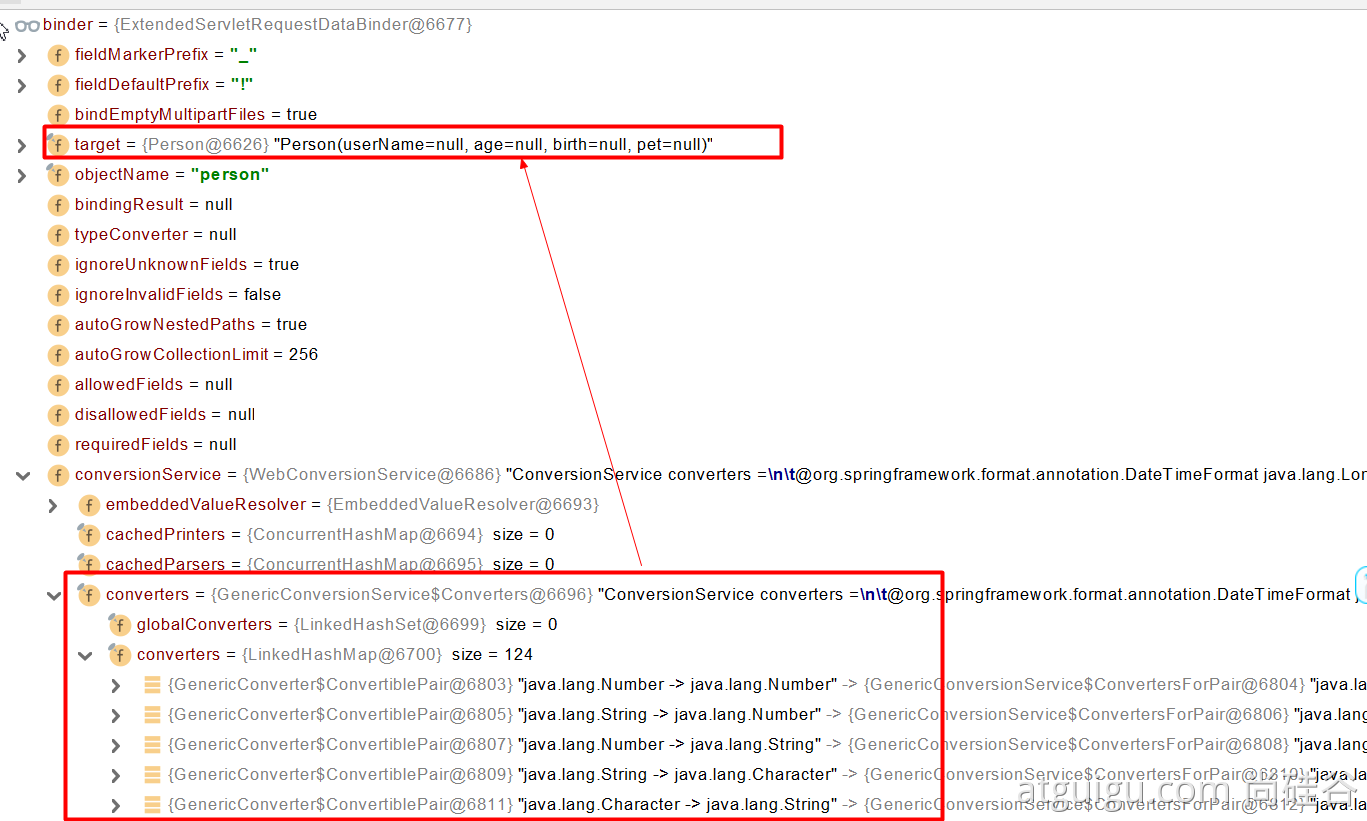第02节_web开发

1.SpringMVC自动配置概览
Spring Boot provides auto-configuration for Spring MVC that works well with most applications.(大多场景我们都无需自定义配置)
The auto-configuration adds the following features on top of Spring’s defaults:
Inclusion of
ContentNegotiatingViewResolverandBeanNameViewResolverbeans.- 内容协商视图解析器和BeanName视图解析器
Support for serving static resources, including support for WebJars (covered later in this document)).
- 静态资源(包括webjars)
Automatic registration of
Converter,GenericConverter, andFormatterbeans.- 自动注册
Converter,GenericConverter,Formatter
- 自动注册
Support for
HttpMessageConverters(covered later in this document).- 支持
HttpMessageConverters(后来我们配合内容协商理解原理)
- 支持
Automatic registration of
MessageCodesResolver(covered later in this document).- 自动注册
MessageCodesResolver(国际化用)
- 自动注册
Static
index.htmlsupport.- 静态index.html 页支持
Custom
Faviconsupport (covered later in this document).- 自定义
Favicon
- 自定义
Automatic use of a
ConfigurableWebBindingInitializerbean (covered later in this document).- 自动使用
ConfigurableWebBindingInitializer,(DataBinder负责将请求数据绑定到JavaBean上)
- 自动使用
If you want to keep those Spring Boot MVC customizations and make more MVC customizations (interceptors, formatters, view controllers, and other features), you can add your own @Configuration class of type WebMvcConfigurer but without @EnableWebMvc.
不用@EnableWebMvc注解。使用 @Configuration + WebMvcConfigurer 自定义规则
If you want to provide custom instances of RequestMappingHandlerMapping, RequestMappingHandlerAdapter, or ExceptionHandlerExceptionResolver, and still keep the Spring Boot MVC customizations, you can declare a bean of type WebMvcRegistrations and use it to provide custom instances of those components.
声明 WebMvcRegistrations 改变默认底层组件
If you want to take complete control of Spring MVC, you can add your own @Configuration annotated with @EnableWebMvc, or alternatively add your own @Configuration-annotated DelegatingWebMvcConfiguration as described in the Javadoc of @EnableWebMvc.
使用 @EnableWebMvc+@Configuration+DelegatingWebMvcConfiguration 全面接管SpringMVC
2.简单功能分析
2.1 静态资源访问
①静态资源目录
只要静态资源放在类路径下: called /static (or /public or /resources or /META-INF/resources
访问 : 当前项目根路径/ + 静态资源名
原理: 静态映射/**。
请求进来,先去找Controller看能不能处理。不能处理的所有请求又都交给静态资源处理器。静态资源也找不到则响应404页面
改变默认的静态资源路径
spring:
mvc:
static-path-pattern: /res/**
resources:
static-locations: [classpath:/haha/]
②静态资源访问前缀
默认无前缀
spring:
mvc:
static-path-pattern: /res/**
当前项目 + static-path-pattern + 静态资源名 = 静态资源文件夹下找
③webjar
自动映射:http://localhost:8080/webjars/jquery/3.5.1/jquery.js
仓库地址:WebJars - Web Libraries in Jars
<dependency>
<groupId>org.webjars</groupId>
<artifactId>jquery</artifactId>
<version>3.5.1</version>
</dependency>
访问地址:http://localhost:8080/webjars/jquery/3.5.1/jquery.js 后面地址要按照依赖里面的包路径
2.2 欢迎页支持
静态资源路径下 index.html
- 可以配置静态资源路径
- 但是不可以配置静态资源的访问前缀。否则导致 index.html不能被默认访问
spring:
# mvc:
# static-path-pattern: /res/** 这个会导致welcome page功能失效
resources:
static-locations: [classpath:/haha/]
- controller能处理/index
2.3 自定义 Favicon
favicon.ico 放在静态资源目录下即可。
spring:
# mvc:
# static-path-pattern: /res/** 这个会导致 Favicon 功能失效
2.4 【源码分析】静态资源配置原理
- SpringBoot启动默认加载
xxxAutoConfiguration类(自动配置类) - SpringMVC功能的自动配置类
WebMvcAutoConfiguration,生效
@Configuration(proxyBeanMethods = false)
@ConditionalOnWebApplication(type = Type.SERVLET)
@ConditionalOnClass({ Servlet.class, DispatcherServlet.class, WebMvcConfigurer.class })
@ConditionalOnMissingBean(WebMvcConfigurationSupport.class)
@AutoConfigureOrder(Ordered.HIGHEST_PRECEDENCE + 10)
@AutoConfigureAfter({ DispatcherServletAutoConfiguration.class, TaskExecutionAutoConfiguration.class,
ValidationAutoConfiguration.class })
public class WebMvcAutoConfiguration {
...
}
- 给容器中配置的内容
- 配置文件的相关属性和xxx进行了绑定。
- WebMvcProperties与spring.mvc文件绑定、
- ResourceProperties与spring.resources文件绑定
@Configuration(proxyBeanMethods = false)
@Import(EnableWebMvcConfiguration.class)
@EnableConfigurationProperties({ WebMvcProperties.class, ResourceProperties.class })
@Order(0)
public static class WebMvcAutoConfigurationAdapter implements WebMvcConfigurer {}
①配置类只有一个有参构造器
//有参构造器所有参数的值都会从容器中确定
//ResourceProperties resourceProperties;获取和spring.resources绑定的所有的值的对象
//WebMvcProperties mvcProperties 获取和spring.mvc绑定的所有的值的对象
//ListableBeanFactory beanFactory Spring的beanFactory
//HttpMessageConverters 找到所有的HttpMessageConverters
//ResourceHandlerRegistrationCustomizer 找到 资源处理器的自定义器。=========
//DispatcherServletPath
//ServletRegistrationBean 给应用注册Servlet、Filter....
public WebMvcAutoConfigurationAdapter(ResourceProperties resourceProperties, WebMvcProperties mvcProperties,
ListableBeanFactory beanFactory, ObjectProvider<HttpMessageConverters> messageConvertersProvider,
ObjectProvider<ResourceHandlerRegistrationCustomizer> resourceHandlerRegistrationCustomizerProvider,
ObjectProvider<DispatcherServletPath> dispatcherServletPath,
ObjectProvider<ServletRegistrationBean<?>> servletRegistrations) {
this.resourceProperties = resourceProperties;
this.mvcProperties = mvcProperties;
this.beanFactory = beanFactory;
this.messageConvertersProvider = messageConvertersProvider;
this.resourceHandlerRegistrationCustomizer = resourceHandlerRegistrationCustomizerProvider.getIfAvailable();
this.dispatcherServletPath = dispatcherServletPath;
this.servletRegistrations = servletRegistrations;
}
- ResourceProperties resourceProperties;获取和spring.resources绑定的所有的值的对象
- WebMvcProperties mvcProperties 获取和spring.mvc绑定的所有的值的对象
- ListableBeanFactory beanFactory Spring的beanFactory
- HttpMessageConverters 找到所有的HttpMessageConverters
- ResourceHandlerRegistrationCustomizer 找到 资源处理器的自定义器。
- DispatcherServletPath
- ServletRegistrationBean 给应用注册Servlet、Filter....
②资源处理的默认规则
...
public class WebMvcAutoConfiguration {
...
public static class EnableWebMvcConfiguration extends DelegatingWebMvcConfiguration implements ResourceLoaderAware {
...
@Override
protected void addResourceHandlers(ResourceHandlerRegistry registry) {
super.addResourceHandlers(registry);
if (!this.resourceProperties.isAddMappings()) {
logger.debug("Default resource handling disabled");
return;
}
ServletContext servletContext = getServletContext();
addResourceHandler(registry, "/webjars/**", "classpath:/META-INF/resources/webjars/");
addResourceHandler(registry, this.mvcProperties.getStaticPathPattern(), (registration) -> {
registration.addResourceLocations(this.resourceProperties.getStaticLocations());
if (servletContext != null) {
registration.addResourceLocations(new ServletContextResource(servletContext, SERVLET_LOCATION));
}
});
}
...
}
...
}
根据上述代码,我们可以同过配置禁止所有静态资源规则。
spring:
resources:
add-mappings: false #禁用所有静态资源规则
静态资源规则:
@ConfigurationProperties(prefix = "spring.resources", ignoreUnknownFields = false)
public class ResourceProperties {
private static final String[] CLASSPATH_RESOURCE_LOCATIONS = { "classpath:/META-INF/resources/",
"classpath:/resources/", "classpath:/static/", "classpath:/public/" };
/**
* Locations of static resources. Defaults to classpath:[/META-INF/resources/,
* /resources/, /static/, /public/].
*/
private String[] staticLocations = CLASSPATH_RESOURCE_LOCATIONS;
...
}
③欢迎页的处理规则
...
public class WebMvcAutoConfiguration {
...
public static class EnableWebMvcConfiguration extends DelegatingWebMvcConfiguration implements ResourceLoaderAware {
...
@Bean
public WelcomePageHandlerMapping welcomePageHandlerMapping(ApplicationContext applicationContext,
FormattingConversionService mvcConversionService, ResourceUrlProvider mvcResourceUrlProvider) {
WelcomePageHandlerMapping welcomePageHandlerMapping = new WelcomePageHandlerMapping(
new TemplateAvailabilityProviders(applicationContext), applicationContext, getWelcomePage(),
this.mvcProperties.getStaticPathPattern());
welcomePageHandlerMapping.setInterceptors(getInterceptors(mvcConversionService, mvcResourceUrlProvider));
welcomePageHandlerMapping.setCorsConfigurations(getCorsConfigurations());
return welcomePageHandlerMapping;
}
WelcomePageHandlerMapping的构造方法如下:
WelcomePageHandlerMapping(TemplateAvailabilityProviders templateAvailabilityProviders,
ApplicationContext applicationContext, Resource welcomePage, String staticPathPattern) {
if (welcomePage != null && "/**".equals(staticPathPattern)) {
//要用欢迎页功能,必须是/**
logger.info("Adding welcome page: " + welcomePage);
setRootViewName("forward:index.html");
}
else if (welcomeTemplateExists(templateAvailabilityProviders, applicationContext)) {
//调用Controller /index
logger.info("Adding welcome page template: index");
setRootViewName("index");
}
}
这构造方法内的代码也解释了欢迎页与favicon功能中配置static-path-pattern后welcome页面和小图标失效的问题。
spring:
mvc:
static-path-pattern: /res/**
④favicon
3.请求参数处理
3.1 【源码分析】请求映射
①rest使用与原理
- @xxxMapping;
- @GetMapping
- @PostMapping
- @PutMapping
- @DeleteMapping
- Rest风格支持(使用HTTP请求方式动词来表示对资源的操作)
- 以前:
- /getUser 获取用户
- /deleteUser 删除用户
- /editUser 修改用户
- /saveUser保存用户
- 现在: /user
- GET-获取用户
- DELETE-删除用户
- PUT-修改用户
- POST-保存用户
- 核心Filter;HiddenHttpMethodFilter
- 以前:
- 用法:
- 开启页面表单的Rest功能
- 页面 form的属性method=post,隐藏域 _method=put、delete等(如果直接get或post,无需隐藏域)
- 编写请求映射
application.yaml:
spring:
mvc:
hiddenmethod:
filter:
enabled: true #开启页面表单的Rest功能
表单页面:
<form action="/user" method="get">
<input value="REST-GET提交" type="submit" />
</form>
<form action="/user" method="post">
<input value="REST-POST提交" type="submit" />
</form>
<form action="/user" method="post">
<input name="_method" type="hidden" value="DELETE"/>
<input value="REST-DELETE 提交" type="submit"/>
</form>
<form action="/user" method="post">
<input name="_method" type="hidden" value="PUT" />
<input value="REST-PUT提交"type="submit" />
<form>
controller:
@RequestMapping(value = "/user",method = RequestMethod.GET)
public String getUser(){
return "GET-张三";
}
@RequestMapping(value = "/user",method = RequestMethod.POST)
public String saveUser(){
return "POST-张三";
}
@RequestMapping(value = "/user",method = RequestMethod.PUT)
public String putUser(){
return "PUT-张三";
}
@RequestMapping(value = "/user",method = RequestMethod.DELETE)
public String deleteUser(){
return "DELETE-张三";
}
@Bean
@ConditionalOnMissingBean(HiddenHttpMethodFilter.class)
@ConditionalOnProperty(prefix = "spring.mvc.hiddenmethod.filter", name = "enabled", matchIfMissing = false)
public OrderedHiddenHttpMethodFilter hiddenHttpMethodFilter() {
return new OrderedHiddenHttpMethodFilter();
}
//自定义filter
@Bean
public HiddenHttpMethodFilter hiddenHttpMethodFilter(){
HiddenHttpMethodFilter methodFilter = new HiddenHttpMethodFilter();
methodFilter.setMethodParam("_m");
return methodFilter;
}
Rest原理(表单提交要使用REST的时候)
- 表单提交会带上
_method=PUT - 请求过来被
HiddenHttpMethodFilter拦截- 请求是否正常,并且是POST
- 获取到
_method的值。 - 兼容以下请求;
PUT.DELETE.PATCH - 原生request(post),包装模式requesWrapper重写了getMethod方法,返回的是传入的值。
- 过滤器链放行的时候用wrapper。以后的方法调用getMethod是调用requesWrapper的。
- 获取到
- 请求是否正常,并且是POST
public class HiddenHttpMethodFilter extends OncePerRequestFilter {
private static final List<String> ALLOWED_METHODS =
Collections.unmodifiableList(Arrays.asList(HttpMethod.PUT.name(),
HttpMethod.DELETE.name(), HttpMethod.PATCH.name()));
/** Default method parameter: {@code _method}. */
public static final String DEFAULT_METHOD_PARAM = "_method";
private String methodParam = DEFAULT_METHOD_PARAM;
/**
* Set the parameter name to look for HTTP methods.
* @see #DEFAULT_METHOD_PARAM
*/
public void setMethodParam(String methodParam) {
Assert.hasText(methodParam, "'methodParam' must not be empty");
this.methodParam = methodParam;
}
@Override
protected void doFilterInternal(HttpServletRequest request, HttpServletResponse response, FilterChain filterChain)
throws ServletException, IOException {
HttpServletRequest requestToUse = request;
if ("POST".equals(request.getMethod()) && request.getAttribute(WebUtils.ERROR_EXCEPTION_ATTRIBUTE) == null) {
String paramValue = request.getParameter(this.methodParam);
if (StringUtils.hasLength(paramValue)) {
String method = paramValue.toUpperCase(Locale.ENGLISH);
if (ALLOWED_METHODS.contains(method)) {
requestToUse = new HttpMethodRequestWrapper(request, method);
}
}
}
filterChain.doFilter(requestToUse, response);
}
/**
* Simple {@link HttpServletRequest} wrapper that returns the supplied method for
* {@link HttpServletRequest#getMethod()}.
*/
private static class HttpMethodRequestWrapper extends HttpServletRequestWrapper {
private final String method;
public HttpMethodRequestWrapper(HttpServletRequest request, String method) {
super(request);
this.method = method;
}
@Override
public String getMethod() {
return this.method;
}
}
}
Rest使用客户端工具,
- 如PostMan直接发送Put、delete等方式请求,无需Filter。
②怎么改变默认的_method
@Configuration(proxyBeanMethods = false)
@ConditionalOnWebApplication(type = Type.SERVLET)
@ConditionalOnClass({ Servlet.class, DispatcherServlet.class, WebMvcConfigurer.class })
@ConditionalOnMissingBean(WebMvcConfigurationSupport.class)
@AutoConfigureOrder(Ordered.HIGHEST_PRECEDENCE + 10)
@AutoConfigureAfter({ DispatcherServletAutoConfiguration.class, TaskExecutionAutoConfiguration.class,
ValidationAutoConfiguration.class })
public class WebMvcAutoConfiguration {
...
@Bean
@ConditionalOnMissingBean(HiddenHttpMethodFilter.class)
@ConditionalOnProperty(prefix = "spring.mvc.hiddenmethod.filter", name = "enabled", matchIfMissing = false)
public OrderedHiddenHttpMethodFilter hiddenHttpMethodFilter() {
return new OrderedHiddenHttpMethodFilter();
}
...
}
@ConditionalOnMissingBean(HiddenHttpMethodFilter.class)意味着在没有HiddenHttpMethodFilter时,才执行hiddenHttpMethodFilter()。因此,我们可以自定义filter,改变默认的\_method。例如:
@Configuration(proxyBeanMethods = false)
public class WebConfig{
//自定义filter
@Bean
public HiddenHttpMethodFilter hiddenHttpMethodFilter(){
HiddenHttpMethodFilter methodFilter = new HiddenHttpMethodFilter();
methodFilter.setMethodParam("_m");
return methodFilter;
}
}
将\_method改成_m。
<form action="/user" method="post">
<input name="_m" type="hidden" value="DELETE"/>
<input value="REST-DELETE 提交" type="submit"/>
</form>
③请求映射原理

SpringMVC功能分析都从 org.springframework.web.servlet.DispatcherServlet -> doDispatch()
protected void doDispatch(HttpServletRequest request, HttpServletResponse response) throws Exception {
HttpServletRequest processedRequest = request;
HandlerExecutionChain mappedHandler = null;
boolean multipartRequestParsed = false;
WebAsyncManager asyncManager = WebAsyncUtils.getAsyncManager(request);
try {
ModelAndView mv = null;
Exception dispatchException = null;
try {
processedRequest = checkMultipart(request);
multipartRequestParsed = (processedRequest != request);
// 找到当前请求使用哪个Handler(Controller的方法)处理
mappedHandler = getHandler(processedRequest);
//HandlerMapping:处理器映射。/xxx->>xxxx
getHandler()方法如下:
@Nullable
protected HandlerExecutionChain getHandler(HttpServletRequest request) throws Exception {
if (this.handlerMappings != null) {
for (HandlerMapping mapping : this.handlerMappings) {
HandlerExecutionChain handler = mapping.getHandler(request);
if (handler != null) {
return handler;
}
}
}
return null;
}
this.handlerMappings在Debug模式下展现的内容:
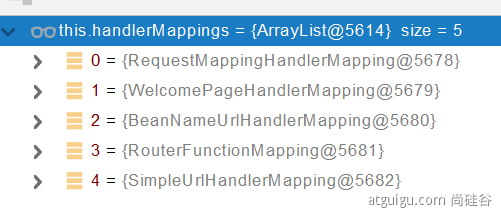
RequestMappingHandlerMapping:保存了所有@RequestMapping 和handler的映射规则。
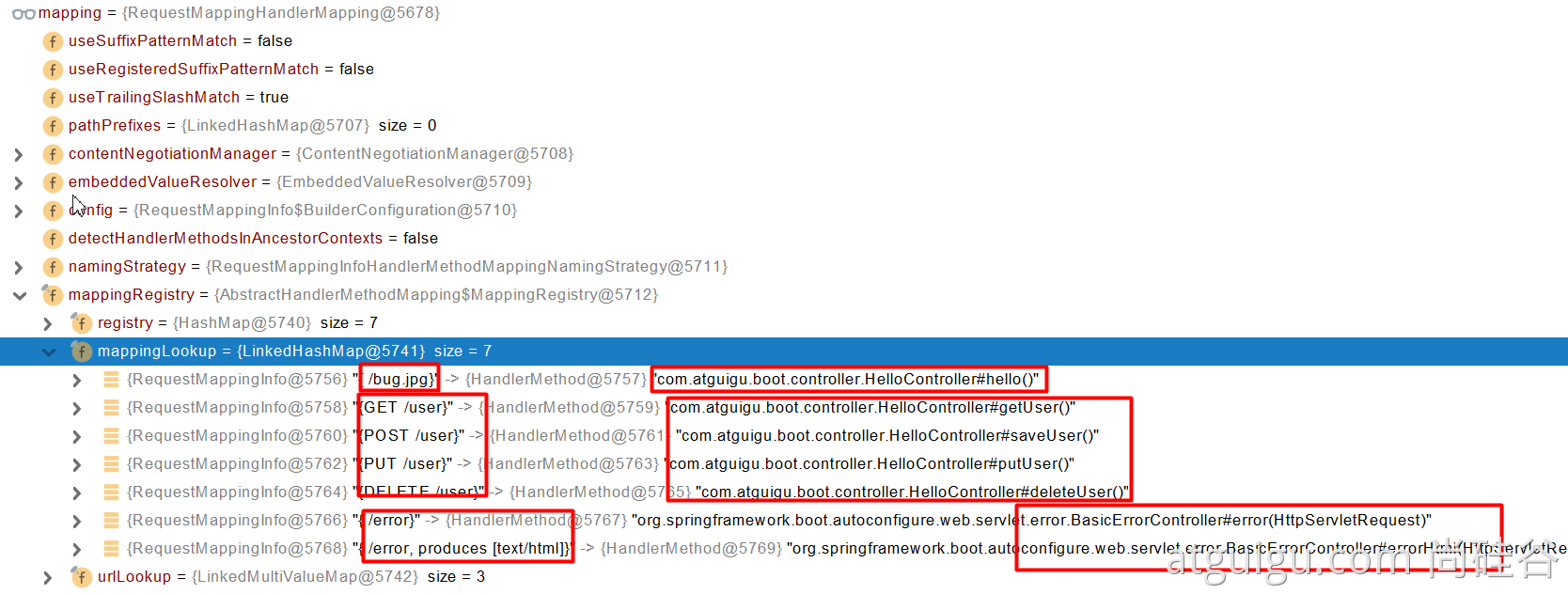
所有的请求映射都在HandlerMapping中。
SpringBoot自动配置欢迎页的 WelcomePageHandlerMapping 。访问
/能访问到index.html;SpringBoot自动配置了默认 的
RequestMappingHandlerMapping请求进来,挨个尝试所有的HandlerMapping看是否有请求信息。
- 如果有就找到这个请求对应的handler
- 如果没有就是下一个 HandlerMapping
我们需要一些自定义的映射处理,我们也可以自己给容器中放HandlerMapping。自定义 HandlerMapping
protected HandlerExecutionChain getHandler(HttpServletRequest request) throws Exception {
if (this.handlerMappings != null) {
for (HandlerMapping mapping : this.handlerMappings) {
HandlerExecutionChain handler = mapping.getHandler(request);
if (handler != null) {
return handler;
}
}
}
return null;
}
3.2 普通参数与基本注解
①注解
@PathVariable路径变量@RequestHeader获取请求头@RequestParam获取请求参数(指问号后的参数,url?a=1&b=2)@CookieValue获取Cookie值@RequestAttribute获取request域属性@RequestBody获取请求体[POST]@MatrixVariable矩阵变量@ModelAttribute
使用用例1:
@RestController
public class ParameterTestController {
// car/2/owner/zhangsan
@GetMapping("/car/{id}/owner/{username}")
public Map<String,Object> getCar(@PathVariable("id") Integer id,
@PathVariable("username") String name,
@PathVariable Map<String,String> pv,
@RequestHeader("User-Agent") String userAgent,
@RequestHeader Map<String,String> header,
@RequestParam("age") Integer age,
@RequestParam("inters") List<String> inters,
@RequestParam Map<String,String> params,
@CookieValue("_ga") String _ga,
@CookieValue("_ga") Cookie cookie){
Map<String,Object> map = new HashMap<>();
// map.put("id",id);
// map.put("name",name);
// map.put("pv",pv);
// map.put("userAgent",userAgent);
// map.put("headers",header);
map.put("age",age);
map.put("inters",inters);
map.put("params",params);
map.put("_ga",_ga);
System.out.println(cookie.getName()+"===>"+cookie.getValue());
return map;
}
@PostMapping("/save")
public Map postMethod(@RequestBody String content){
Map<String,Object> map = new HashMap<>();
map.put("content",content);
return map;
}
//1、语法: 请求路径:/cars/sell;low=34;brand=byd,audi,yd
//2、SpringBoot默认是禁用了矩阵变量的功能
// 手动开启:原理。对于路径的处理。UrlPathHelper进行解析。
// removeSemicolonContent(移除分号内容)支持矩阵变量的
//3、矩阵变量必须有url路径变量才能被解析
@GetMapping("/cars/{path}")
public Map carsSell(@MatrixVariable("low") Integer low,
@MatrixVariable("brand") List<String> brand,
@PathVariable("path") String path){
Map<String,Object> map = new HashMap<>();
map.put("low",low);
map.put("brand",brand);
map.put("path",path);
return map;
}
// /boss/1;age=20/2;age=10
@GetMapping("/boss/{bossId}/{empId}")
public Map boss(@MatrixVariable(value = "age",pathVar = "bossId") Integer bossAge,
@MatrixVariable(value = "age",pathVar = "empId") Integer empAge){
Map<String,Object> map = new HashMap<>();
map.put("bossAge",bossAge);
map.put("empAge",empAge);
return map;
}
}
使用用例2:
- @RequestAttribute:
@Controller
public class RequestController {
@GetMapping("/goto")
public String goToPage(HttpServletRequest request){
request.setAttribute("msg","成功了...");
request.setAttribute("code",200);
return "forward:/success"; //转发到 /success请求
}
@GetMapping("/params")
public String testParam(Map<String,Object> map,
Model model,
HttpServletRequest request,
HttpServletResponse response){
map.put("hello","world666");
model.addAttribute("world","hello666");
request.setAttribute("message","HelloWorld");
Cookie cookie = new Cookie("c1","v1");
response.addCookie(cookie);
return "forward:/success";
}
///<-----------------主角@RequestAttribute在这个方法
@ResponseBody
@GetMapping("/success")
public Map success(@RequestAttribute(value = "msg",required = false) String msg,
@RequestAttribute(value = "code",required = false)Integer code,
HttpServletRequest request){
Object msg1 = request.getAttribute("msg");
Map<String,Object> map = new HashMap<>();
Object hello = request.getAttribute("hello");
Object world = request.getAttribute("world");
Object message = request.getAttribute("message");
map.put("reqMethod_msg",msg1);
map.put("annotation_msg",msg);
map.put("hello",hello);
map.put("world",world);
map.put("message",message);
return map;
}
}
使用用例3:
- @MatrixVariable与UrlPathHelper
语法: 请求路径:
/cars/sell;low=34;brand=byd,audi,ydSpringBoot默认是禁用了矩阵变量的功能
- 手动开启:原理。对于路径的处理。UrlPathHelper的removeSemicolonContent设置为false,让其支持矩阵变量的。
矩阵变量必须有url路径变量才能被解析
手动开启矩阵变量:
- 方式一:实现
WebMvcConfigurer接口:
@Configuration(proxyBeanMethods = false)
public class WebConfig implements WebMvcConfigurer {
@Override
public void configurePathMatch(PathMatchConfigurer configurer) {
UrlPathHelper urlPathHelper = new UrlPathHelper();
// 不移除;后面的内容。矩阵变量功能就可以生效
urlPathHelper.setRemoveSemicolonContent(false);
configurer.setUrlPathHelper(urlPathHelper);
}
}
- 方式二:创建返回
WebMvcConfigurerBean:
@Configuration(proxyBeanMethods = false)
public class WebConfig{
@Bean
public WebMvcConfigurer webMvcConfigurer(){
return new WebMvcConfigurer() {
@Override
public void configurePathMatch(PathMatchConfigurer configurer) {
UrlPathHelper urlPathHelper = new UrlPathHelper();
// 不移除;后面的内容。矩阵变量功能就可以生效
urlPathHelper.setRemoveSemicolonContent(false);
configurer.setUrlPathHelper(urlPathHelper);
}
}
}
}
@MatrixVariable的用例
@RestController
public class ParameterTestController {
///cars/sell;low=34;brand=byd,audi,yd
@GetMapping("/cars/{path}")
public Map carsSell(@MatrixVariable("low") Integer low,
@MatrixVariable("brand") List<String> brand,
@PathVariable("path") String path){
Map<String,Object> map = new HashMap<>();
map.put("low",low);
map.put("brand",brand);
map.put("path",path);
return map;
}
// /boss/1;age=20/2;age=10
@GetMapping("/boss/{bossId}/{empId}")
public Map boss(@MatrixVariable(value = "age",pathVar = "bossId") Integer bossAge,
@MatrixVariable(value = "age",pathVar = "empId") Integer empAge){
Map<String,Object> map = new HashMap<>();
map.put("bossAge",bossAge);
map.put("empAge",empAge);
return map;
}
}
②Servlet API
WebRequest、ServletRequest、MultipartRequest、 HttpSession、javax.servlet.http.PushBuilder、Principal、InputStream、Reader、HttpMethod、Locale、TimeZone、ZoneId
ServletRequestMethodArgumentResolver 以上的部分参数
@Override
public boolean supportsParameter(MethodParameter parameter) {
Class<?> paramType = parameter.getParameterType();
return (WebRequest.class.isAssignableFrom(paramType) ||
ServletRequest.class.isAssignableFrom(paramType) ||
MultipartRequest.class.isAssignableFrom(paramType) ||
HttpSession.class.isAssignableFrom(paramType) ||
(pushBuilder != null && pushBuilder.isAssignableFrom(paramType)) ||
Principal.class.isAssignableFrom(paramType) ||
InputStream.class.isAssignableFrom(paramType) ||
Reader.class.isAssignableFrom(paramType) ||
HttpMethod.class == paramType ||
Locale.class == paramType ||
TimeZone.class == paramType ||
ZoneId.class == paramType);
}
③复杂参数
Map、Model(map、model里面的数据会被放在request的请求域 request.setAttribute)、Errors/BindingResult、RedirectAttributes( 重定向携带数据)**、**ServletResponse(response)、SessionStatus、UriComponentsBuilder、ServletUriComponentsBuilder
Map<String,Object> map,
Model model,
HttpServletRequest request
//以上都是可以给request域中放数据,
request.getAttribute();
Map、Model类型的参数,会返回 mavContainer.getModel();---> BindingAwareModelMap 是Model 也是Map
mavContainer.getModel(); 获取到值的


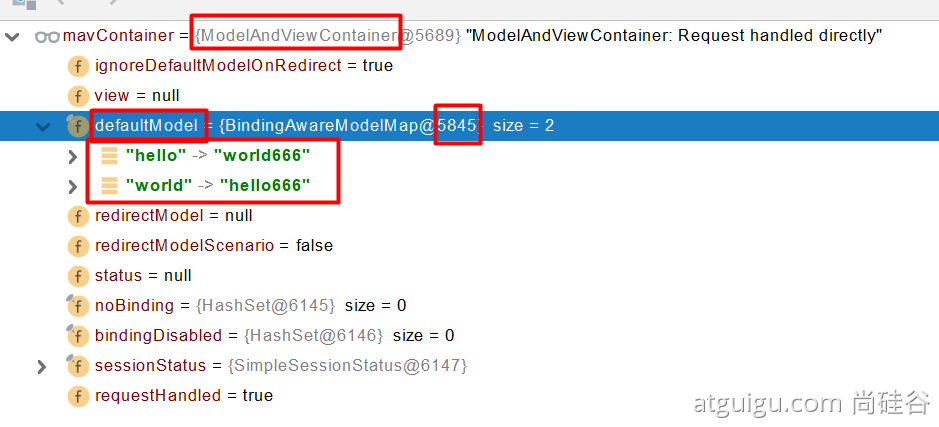
④自定义对象参数
可以自动类型转换与格式化,可以级联封装。
/**
* 姓名: <input name="userName"/> <br/>
* 年龄: <input name="age"/> <br/>
* 生日: <input name="birth"/> <br/>
* 宠物姓名:<input name="pet.name"/><br/>
* 宠物年龄:<input name="pet.age"/>
*/
@Data
public class Person {
private String userName;
private Integer age;
private Date birth;
private Pet pet;
}
@Data
public class Pet {
private String name;
private String age;
}
result
3.3 POJO封装过程
- ServletModelAttributeMethodProcessor
3.4【源码分析】参数处理原理
这要从DispatcherServlet开始说起:
public class DispatcherServlet extends FrameworkServlet {
protected void doDispatch(HttpServletRequest request, HttpServletResponse response) throws Exception {
HttpServletRequest processedRequest = request;
HandlerExecutionChain mappedHandler = null;
boolean multipartRequestParsed = false;
WebAsyncManager asyncManager = WebAsyncUtils.getAsyncManager(request);
try {
ModelAndView mv = null;
Exception dispatchException = null;
try {
processedRequest = checkMultipart(request);
multipartRequestParsed = (processedRequest != request);
// Determine handler for the current request.
mappedHandler = getHandler(processedRequest);
if (mappedHandler == null) {
noHandlerFound(processedRequest, response);
return;
}
// Determine handler adapter for the current request.
HandlerAdapter ha = getHandlerAdapter(mappedHandler.getHandler());
...
HandlerMapping中找到能处理请求的Handler(Controller.method())。- 为当前Handler 找一个适配器
HandlerAdapter,用的最多的是RequestMappingHandlerAdapter。 - 适配器执行目标方法并确定方法参数的每一个值。
①HandlerAdapter

0 - 支持方法上标注@RequestMapping
1 - 支持函数式编程的
②执行目标方法
// Actually invoke the handler.
//DispatcherServlet -- doDispatch
mv = ha.handle(processedRequest, response, mappedHandler.getHandler());
//执行目标方法
mav = invokeHandlerMethod(request, response, handlerMethod);
//ServletInvocableHandlerMethod
Object returnValue = invokeForRequest(webRequest, mavContainer, providedArgs);
//获取方法的参数值
Object[] args = getMethodArgumentValues(request, mavContainer, providedArgs);
③参数解析器-HandlerMethodArgumentResolver
确定将要执行的目标方法的每一个参数的值是什么;
SpringMVC目标方法能写多少种参数类型。取决于参数解析器。
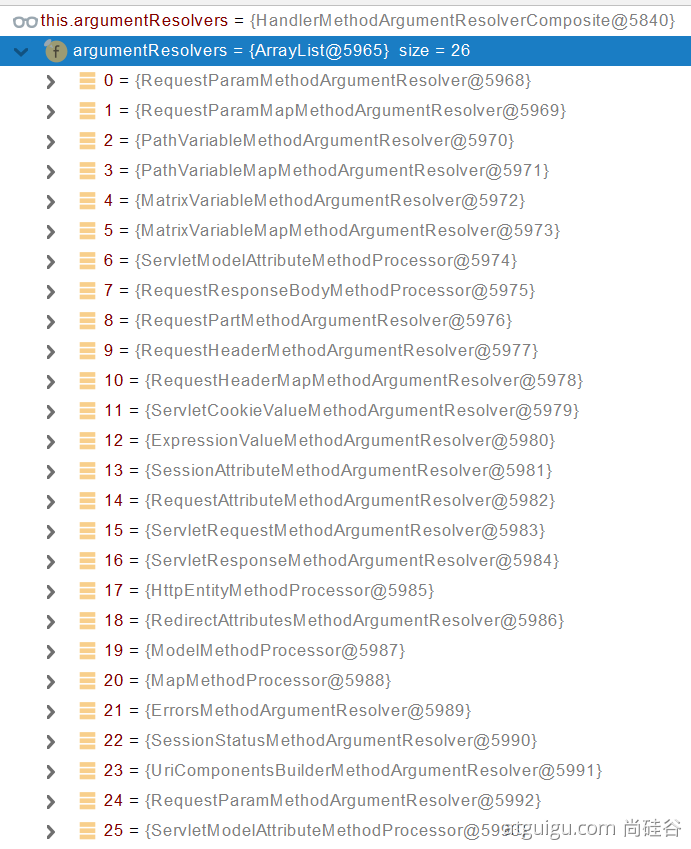

- 当前解析器是否支持解析这种参数
- 支持就调用
resolveArgument
④返回值处理器

⑤如何确定目标方法每一个参数的值
============InvocableHandlerMethod==========================
protected Object[] getMethodArgumentValues(NativeWebRequest request, @Nullable ModelAndViewContainer mavContainer,
Object... providedArgs) throws Exception {
MethodParameter[] parameters = getMethodParameters();
if (ObjectUtils.isEmpty(parameters)) {
return EMPTY_ARGS;
}
Object[] args = new Object[parameters.length];
for (int i = 0; i < parameters.length; i++) {
MethodParameter parameter = parameters[i];
parameter.initParameterNameDiscovery(this.parameterNameDiscoverer);
args[i] = findProvidedArgument(parameter, providedArgs);
if (args[i] != null) {
continue;
}
if (!this.resolvers.supportsParameter(parameter)) {
throw new IllegalStateException(formatArgumentError(parameter, "No suitable resolver"));
}
try {
args[i] = this.resolvers.resolveArgument(parameter, mavContainer, request, this.dataBinderFactory);
}
catch (Exception ex) {
// Leave stack trace for later, exception may actually be resolved and handled...
if (logger.isDebugEnabled()) {
String exMsg = ex.getMessage();
if (exMsg != null && !exMsg.contains(parameter.getExecutable().toGenericString())) {
logger.debug(formatArgumentError(parameter, exMsg));
}
}
throw ex;
}
}
return args;
}
【1】挨个判断所有参数解析器哪个支持解析这个参数
@Nullable
private HandlerMethodArgumentResolver getArgumentResolver(MethodParameter parameter) {
HandlerMethodArgumentResolver result = this.argumentResolverCache.get(parameter);
if (result == null) {
for (HandlerMethodArgumentResolver resolver : this.argumentResolvers) {
if (resolver.supportsParameter(parameter)) {
result = resolver;
this.argumentResolverCache.put(parameter, result);
break;
}
}
}
return result;
}
【2】解析这个参数的值
调用各自 HandlerMethodArgumentResolver 的 resolveArgument 方法即可
【3】定义类型参数封装POJO
ServletModelAttributeMethodProcessor 这个参数处理器支持
是否为简单类型。
public static boolean isSimpleValueType(Class<?> type) {
return (Void.class != type && void.class != type &&
(ClassUtils.isPrimitiveOrWrapper(type) ||
Enum.class.isAssignableFrom(type) ||
CharSequence.class.isAssignableFrom(type) ||
Number.class.isAssignableFrom(type) ||
Date.class.isAssignableFrom(type) ||
Temporal.class.isAssignableFrom(type) ||
URI.class == type ||
URL.class == type ||
Locale.class == type ||
Class.class == type));
}
@Override
@Nullable
public final Object resolveArgument(MethodParameter parameter, @Nullable ModelAndViewContainer mavContainer,
NativeWebRequest webRequest, @Nullable WebDataBinderFactory binderFactory) throws Exception {
Assert.state(mavContainer != null, "ModelAttributeMethodProcessor requires ModelAndViewContainer");
Assert.state(binderFactory != null, "ModelAttributeMethodProcessor requires WebDataBinderFactory");
String name = ModelFactory.getNameForParameter(parameter);
ModelAttribute ann = parameter.getParameterAnnotation(ModelAttribute.class);
if (ann != null) {
mavContainer.setBinding(name, ann.binding());
}
Object attribute = null;
BindingResult bindingResult = null;
if (mavContainer.containsAttribute(name)) {
attribute = mavContainer.getModel().get(name);
}
else {
// Create attribute instance
try {
attribute = createAttribute(name, parameter, binderFactory, webRequest);
}
catch (BindException ex) {
if (isBindExceptionRequired(parameter)) {
// No BindingResult parameter -> fail with BindException
throw ex;
}
// Otherwise, expose null/empty value and associated BindingResult
if (parameter.getParameterType() == Optional.class) {
attribute = Optional.empty();
}
bindingResult = ex.getBindingResult();
}
}
if (bindingResult == null) {
// Bean property binding and validation;
// skipped in case of binding failure on construction.
WebDataBinder binder = binderFactory.createBinder(webRequest, attribute, name);
if (binder.getTarget() != null) {
if (!mavContainer.isBindingDisabled(name)) {
bindRequestParameters(binder, webRequest);
}
validateIfApplicable(binder, parameter);
if (binder.getBindingResult().hasErrors() && isBindExceptionRequired(binder, parameter)) {
throw new BindException(binder.getBindingResult());
}
}
// Value type adaptation, also covering java.util.Optional
if (!parameter.getParameterType().isInstance(attribute)) {
attribute = binder.convertIfNecessary(binder.getTarget(), parameter.getParameterType(), parameter);
}
bindingResult = binder.getBindingResult();
}
// Add resolved attribute and BindingResult at the end of the model
Map<String, Object> bindingResultModel = bindingResult.getModel();
mavContainer.removeAttributes(bindingResultModel);
mavContainer.addAllAttributes(bindingResultModel);
return attribute;
}
WebDataBinder binder = binderFactory.createBinder(webRequest, attribute, name);
WebDataBinder :web数据绑定器,将请求参数的值绑定到指定的JavaBean里面
WebDataBinder 利用它里面的 Converters 将请求数据转成指定的数据类型。再次封装到JavaBean中
GenericConversionService:在设置每一个值的时候,找它里面的所有converter那个可以将这个数据类型(request带来参数的字符串)转换到指定的类型(JavaBean -- Integer)
byte -- > file
@FunctionalInterface public interface Converter<S, T>

【4】自定义Converter原理
未来我们可以给WebDataBinder里面放自己的Converter;
private static final class StringToNumber<T extends Number> implements Converter<String, T>
下面演示将字符串“啊猫,3”转换成Pet对象。
自定义 Converter:
//1、WebMvcConfigurer定制化SpringMVC的功能
@Bean
public WebMvcConfigurer webMvcConfigurer(){
return new WebMvcConfigurer() {
@Override
public void configurePathMatch(PathMatchConfigurer configurer) {
UrlPathHelper urlPathHelper = new UrlPathHelper();
// 不移除;后面的内容。矩阵变量功能就可以生效
urlPathHelper.setRemoveSemicolonContent(false);
configurer.setUrlPathHelper(urlPathHelper);
}
@Override
public void addFormatters(FormatterRegistry registry) {
registry.addConverter(new Converter<String, Pet>() {
@Override
public Pet convert(String source) {
// 啊猫,3
if(!StringUtils.isEmpty(source)){
Pet pet = new Pet();
String[] split = source.split(",");
pet.setName(split[0]);
pet.setAge(Integer.parseInt(split[1]));
return pet;
}
return null;
}
});
}
};
}
⑥目标方法执行完成
将所有的数据都放在 ModelAndViewContainer;包含要去的页面地址View。还包含Model数据。
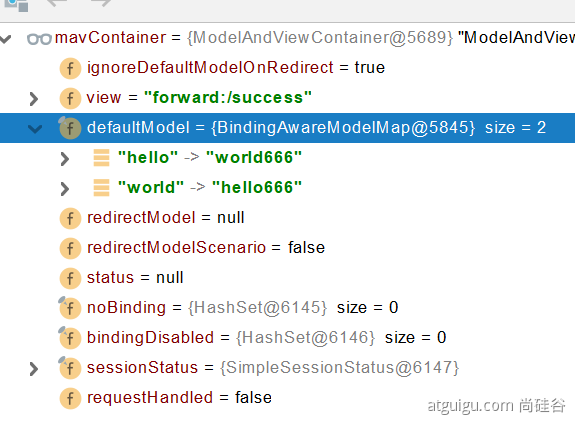
⑦处理派发结果
processDispatchResult(processedRequest, response, mappedHandler, mv, dispatchException);renderMergedOutputModel(mergedModel, getRequestToExpose(request), response);
InternalResourceView:
@Override
protected void renderMergedOutputModel(
Map<String, Object> model, HttpServletRequest request, HttpServletResponse response) throws Exception {
// Expose the model object as request attributes.
exposeModelAsRequestAttributes(model, request);
// Expose helpers as request attributes, if any.
exposeHelpers(request);
// Determine the path for the request dispatcher.
String dispatcherPath = prepareForRendering(request, response);
// Obtain a RequestDispatcher for the target resource (typically a JSP).
RequestDispatcher rd = getRequestDispatcher(request, dispatcherPath);
if (rd == null) {
throw new ServletException("Could not get RequestDispatcher for [" + getUrl() +
"]: Check that the corresponding file exists within your web application archive!");
}
// If already included or response already committed, perform include, else forward.
if (useInclude(request, response)) {
response.setContentType(getContentType());
if (logger.isDebugEnabled()) {
logger.debug("Including [" + getUrl() + "]");
}
rd.include(request, response);
}
else {
// Note: The forwarded resource is supposed to determine the content type itself.
if (logger.isDebugEnabled()) {
logger.debug("Forwarding to [" + getUrl() + "]");
}
rd.forward(request, response);
}
}
暴露模型作为请求域属性
// Expose the model object as request attributes.
exposeModelAsRequestAttributes(model, request);
protected void exposeModelAsRequestAttributes(Map<String, Object> model,
HttpServletRequest request) throws Exception {
//model中的所有数据遍历挨个放在请求域中
model.forEach((name, value) -> {
if (value != null) {
request.setAttribute(name, value);
}
else {
request.removeAttribute(name);
}
});
}
4.数据响应与内容协商
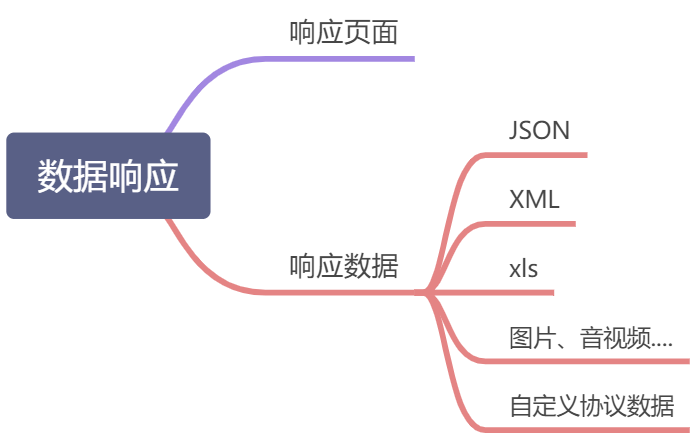
4.1 响应JSON
①jackson.jar+@ResponseBody
<dependency>
<groupId>org.springframework.boot</groupId>
<artifactId>spring-boot-starter-web</artifactId>
</dependency>
引入spring-boot-starter-web场景后自动引入了json场景
<dependency>
<groupId>org.springframework.boot</groupId>
<artifactId>spring-boot-starter-json</artifactId>
<version>2.3.4.RELEASE</version>
<scope>compile</scope>
</dependency>

给前端自动返回json数据;
控制层代码如下:
@Controller
public class ResponseTestController {
@ResponseBody //利用返回值处理器里面的消息转换器进行处理
@GetMapping(value = "/test/person")
public Person getPerson(){
Person person = new Person();
person.setAge(28);
person.setBirth(new Date());
person.setUserName("zhangsan");
return person;
}
}
【1】返回值解析器
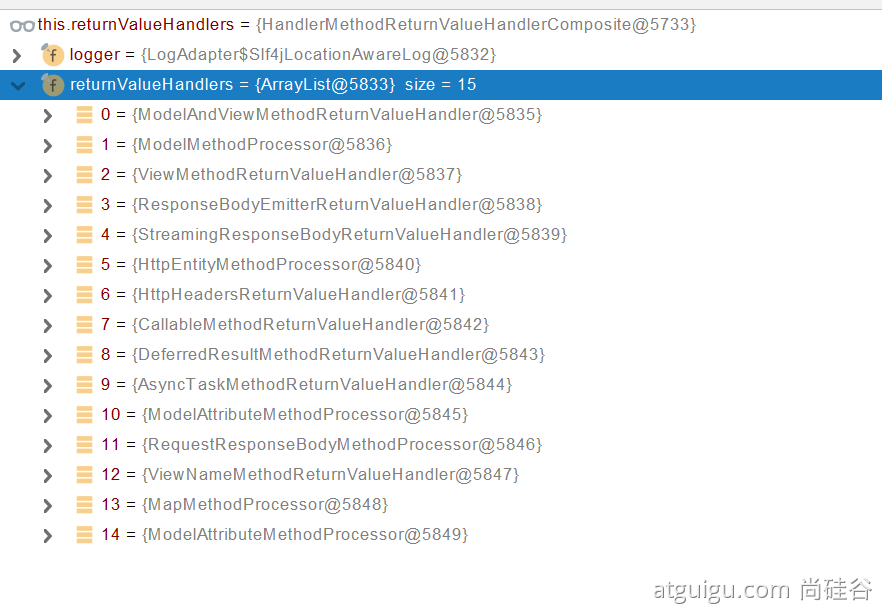
try {
this.returnValueHandlers.handleReturnValue(
returnValue, getReturnValueType(returnValue), mavContainer, webRequest);
}
@Override
public void handleReturnValue(@Nullable Object returnValue, MethodParameter returnType,
ModelAndViewContainer mavContainer, NativeWebRequest webRequest) throws Exception {
HandlerMethodReturnValueHandler handler = selectHandler(returnValue, returnType);
if (handler == null) {
throw new IllegalArgumentException("Unknown return value type: " + returnType.getParameterType().getName());
}
handler.handleReturnValue(returnValue, returnType, mavContainer, webRequest);
}
RequestResponseBodyMethodProcessor
@Override
public void handleReturnValue(@Nullable Object returnValue, MethodParameter returnType,
ModelAndViewContainer mavContainer, NativeWebRequest webRequest)
throws IOException, HttpMediaTypeNotAcceptableException, HttpMessageNotWritableException {
mavContainer.setRequestHandled(true);
ServletServerHttpRequest inputMessage = createInputMessage(webRequest);
ServletServerHttpResponse outputMessage = createOutputMessage(webRequest);
// Try even with null return value. ResponseBodyAdvice could get involved.
// 使用消息转换器进行写出操作
writeWithMessageConverters(returnValue, returnType, inputMessage, outputMessage);
}
【2】返回值解析器原理
返回值处理器判断是否支持这种类型返回值
supportsReturnType返回值处理器调用
handleReturnValue进行处理RequestResponseBodyMethodProcessor可以处理返回值标了@ResponseBody注解的。- 利用
MessageConverters进行处理将数据写为 json内容协商(浏览器默认会以请求头的方式告诉服务器他能接受什么样的内容类型)
服务器最终根据自己自身的能力,决定服务器能生产出什么样内容类型的数据,
SpringMVC会挨个遍历所有容器底层的
HttpMessageConverter,看谁能处理- 得到
MappingJackson2HttpMessageConverter可以将对象写为 json - 利用
MappingJackson2HttpMessageConverter将对象转为json再写出去。
- 得到
- 利用

//RequestResponseBodyMethodProcessor继承这类
public abstract class AbstractMessageConverterMethodProcessor extends AbstractMessageConverterMethodArgumentResolver
implements HandlerMethodReturnValueHandler {
...
//承接上一节内容
protected <T> void writeWithMessageConverters(@Nullable T value, MethodParameter returnType,
ServletServerHttpRequest inputMessage, ServletServerHttpResponse outputMessage)
throws IOException, HttpMediaTypeNotAcceptableException, HttpMessageNotWritableException {
Object body;
Class<?> valueType;
Type targetType;
if (value instanceof CharSequence) {
body = value.toString();
valueType = String.class;
targetType = String.class;
}
else {
body = value;
valueType = getReturnValueType(body, returnType);
targetType = GenericTypeResolver.resolveType(getGenericType(returnType), returnType.getContainingClass());
}
...
//内容协商(浏览器默认会以请求头(参数Accept)的方式告诉服务器他能接受什么样的内容类型)
MediaType selectedMediaType = null;
MediaType contentType = outputMessage.getHeaders().getContentType();
boolean isContentTypePreset = contentType != null && contentType.isConcrete();
if (isContentTypePreset) {
if (logger.isDebugEnabled()) {
logger.debug("Found 'Content-Type:" + contentType + "' in response");
}
selectedMediaType = contentType;
}
else {
HttpServletRequest request = inputMessage.getServletRequest();
List<MediaType> acceptableTypes = getAcceptableMediaTypes(request);
//服务器最终根据自己自身的能力,决定服务器能生产出什么样内容类型的数据
List<MediaType> producibleTypes = getProducibleMediaTypes(request, valueType, targetType);
if (body != null && producibleTypes.isEmpty()) {
throw new HttpMessageNotWritableException(
"No converter found for return value of type: " + valueType);
}
List<MediaType> mediaTypesToUse = new ArrayList<>();
for (MediaType requestedType : acceptableTypes) {
for (MediaType producibleType : producibleTypes) {
if (requestedType.isCompatibleWith(producibleType)) {
mediaTypesToUse.add(getMostSpecificMediaType(requestedType, producibleType));
}
}
}
if (mediaTypesToUse.isEmpty()) {
if (body != null) {
throw new HttpMediaTypeNotAcceptableException(producibleTypes);
}
if (logger.isDebugEnabled()) {
logger.debug("No match for " + acceptableTypes + ", supported: " + producibleTypes);
}
return;
}
MediaType.sortBySpecificityAndQuality(mediaTypesToUse);
//选择一个MediaType
for (MediaType mediaType : mediaTypesToUse) {
if (mediaType.isConcrete()) {
selectedMediaType = mediaType;
break;
}
else if (mediaType.isPresentIn(ALL_APPLICATION_MEDIA_TYPES)) {
selectedMediaType = MediaType.APPLICATION_OCTET_STREAM;
break;
}
}
if (logger.isDebugEnabled()) {
logger.debug("Using '" + selectedMediaType + "', given " +
acceptableTypes + " and supported " + producibleTypes);
}
}
if (selectedMediaType != null) {
selectedMediaType = selectedMediaType.removeQualityValue();
//本节主角:HttpMessageConverter
for (HttpMessageConverter<?> converter : this.messageConverters) {
GenericHttpMessageConverter genericConverter = (converter instanceof GenericHttpMessageConverter ?
(GenericHttpMessageConverter<?>) converter : null);
//判断是否可写
if (genericConverter != null ?
((GenericHttpMessageConverter) converter).canWrite(targetType, valueType, selectedMediaType) :
converter.canWrite(valueType, selectedMediaType)) {
body = getAdvice().beforeBodyWrite(body, returnType, selectedMediaType,
(Class<? extends HttpMessageConverter<?>>) converter.getClass(),
inputMessage, outputMessage);
if (body != null) {
Object theBody = body;
LogFormatUtils.traceDebug(logger, traceOn ->
"Writing [" + LogFormatUtils.formatValue(theBody, !traceOn) + "]");
addContentDispositionHeader(inputMessage, outputMessage);
//开始写入
if (genericConverter != null) {
genericConverter.write(body, targetType, selectedMediaType, outputMessage);
}
else {
((HttpMessageConverter) converter).write(body, selectedMediaType, outputMessage);
}
}
else {
if (logger.isDebugEnabled()) {
logger.debug("Nothing to write: null body");
}
}
return;
}
}
}
...
}
HTTPMessageConverter接口:
/**
* Strategy interface for converting from and to HTTP requests and responses.
*/
public interface HttpMessageConverter<T> {
/**
* Indicates whether the given class can be read by this converter.
*/
boolean canRead(Class<?> clazz, @Nullable MediaType mediaType);
/**
* Indicates whether the given class can be written by this converter.
*/
boolean canWrite(Class<?> clazz, @Nullable MediaType mediaType);
/**
* Return the list of {@link MediaType} objects supported by this converter.
*/
List<MediaType> getSupportedMediaTypes();
/**
* Read an object of the given type from the given input message, and returns it.
*/
T read(Class<? extends T> clazz, HttpInputMessage inputMessage)
throws IOException, HttpMessageNotReadableException;
/**
* Write an given object to the given output message.
*/
void write(T t, @Nullable MediaType contentType, HttpOutputMessage outputMessage)
throws IOException, HttpMessageNotWritableException;
}
②SpringMVC到底支持哪些返回值
ModelAndView
Model
View
ResponseEntity
ResponseBodyEmitter
StreamingResponseBody
HttpEntity
HttpHeaders
Callable
DeferredResult
ListenableFuture
CompletionStage
WebAsyncTask
有@ModelAttribute且为对象类型的
@ResponseBody注解 ---> RequestResponseBodyMethodProcessor;
③HTTPMessageConverter原理
【1】MessageConverter规范
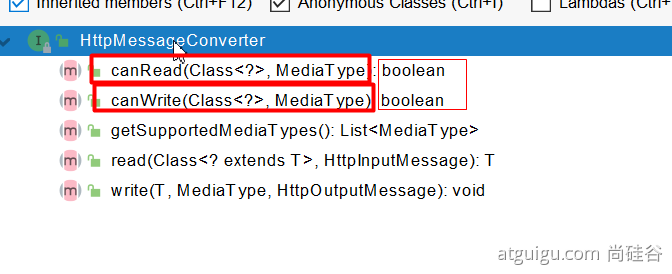
HttpMessageConverter: 看是否支持将此Class类型的对象,转为MediaType类型的数据。
例子:Person对象转为JSON。或者 JSON转为Person
【2】默认的MessageConverter

0 - 只支持Byte类型的
1 - String
2 - String
3 - Resource
4 - ResourceRegion
5 - DOMSource.class \ SAXSource.class) \ StAXSource.class \ StreamSource.class \ Source.class
6 - MultiValueMap
7 - true
8 - true
9 - 支持注解方式xml处理的。
最终 MappingJackson2HttpMessageConverter 把对象转为JSON(利用底层的jackson的objectMapper转换的)

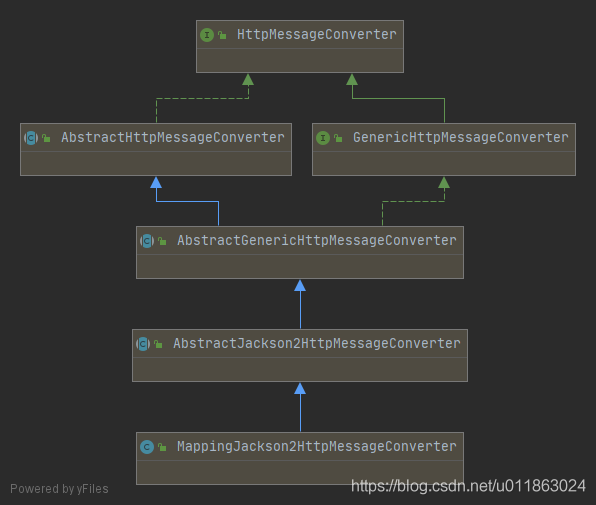
关于MappingJackson2HttpMessageConverter的实例化如下。
关于HttpMessageConverters的初始化:
DispatcherServlet的初始化时会调用initHandlerAdapters(ApplicationContext context)
public class DispatcherServlet extends FrameworkServlet {
...
private void initHandlerAdapters(ApplicationContext context) {
this.handlerAdapters = null;
if (this.detectAllHandlerAdapters) {
// Find all HandlerAdapters in the ApplicationContext, including ancestor contexts.
Map<String, HandlerAdapter> matchingBeans =
BeanFactoryUtils.beansOfTypeIncludingAncestors(context, HandlerAdapter.class, true, false);
if (!matchingBeans.isEmpty()) {
this.handlerAdapters = new ArrayList<>(matchingBeans.values());
// We keep HandlerAdapters in sorted order.
AnnotationAwareOrderComparator.sort(this.handlerAdapters);
}
}
...
上述代码会加载ApplicationContext的所有HandlerAdapter,用来处理@RequestMapping的RequestMappingHandlerAdapter实现HandlerAdapter接口,RequestMappingHandlerAdapter也被实例化。
public class RequestMappingHandlerAdapter extends AbstractHandlerMethodAdapter
implements BeanFactoryAware, InitializingBean {
...
private List<HttpMessageConverter<?>> messageConverters;
...
public RequestMappingHandlerAdapter() {
this.messageConverters = new ArrayList<>(4);
this.messageConverters.add(new ByteArrayHttpMessageConverter());
this.messageConverters.add(new StringHttpMessageConverter());
if (!shouldIgnoreXml) {
try {
this.messageConverters.add(new SourceHttpMessageConverter<>());
}
catch (Error err) {
// Ignore when no TransformerFactory implementation is available
}
}
this.messageConverters.add(new AllEncompassingFormHttpMessageConverter());
}
在构造器中看到一堆HttpMessageConverter。接着,重点查看AllEncompassingFormHttpMessageConverter类:
public class AllEncompassingFormHttpMessageConverter extends FormHttpMessageConverter {
/**
* Boolean flag controlled by a {@code spring.xml.ignore} system property that instructs Spring to
* ignore XML, i.e. to not initialize the XML-related infrastructure.
* <p>The default is "false".
*/
private static final boolean shouldIgnoreXml = SpringProperties.getFlag("spring.xml.ignore");
private static final boolean jaxb2Present;
private static final boolean jackson2Present;
private static final boolean jackson2XmlPresent;
private static final boolean jackson2SmilePresent;
private static final boolean gsonPresent;
private static final boolean jsonbPresent;
private static final boolean kotlinSerializationJsonPresent;
static {
ClassLoader classLoader = AllEncompassingFormHttpMessageConverter.class.getClassLoader();
jaxb2Present = ClassUtils.isPresent("javax.xml.bind.Binder", classLoader);
jackson2Present = ClassUtils.isPresent("com.fasterxml.jackson.databind.ObjectMapper", classLoader) &&
ClassUtils.isPresent("com.fasterxml.jackson.core.JsonGenerator", classLoader);
jackson2XmlPresent = ClassUtils.isPresent("com.fasterxml.jackson.dataformat.xml.XmlMapper", classLoader);
jackson2SmilePresent = ClassUtils.isPresent("com.fasterxml.jackson.dataformat.smile.SmileFactory", classLoader);
gsonPresent = ClassUtils.isPresent("com.google.gson.Gson", classLoader);
jsonbPresent = ClassUtils.isPresent("javax.json.bind.Jsonb", classLoader);
kotlinSerializationJsonPresent = ClassUtils.isPresent("kotlinx.serialization.json.Json", classLoader);
}
public AllEncompassingFormHttpMessageConverter() {
if (!shouldIgnoreXml) {
try {
addPartConverter(new SourceHttpMessageConverter<>());
}
catch (Error err) {
// Ignore when no TransformerFactory implementation is available
}
if (jaxb2Present && !jackson2XmlPresent) {
addPartConverter(new Jaxb2RootElementHttpMessageConverter());
}
}
if (jackson2Present) {
addPartConverter(new MappingJackson2HttpMessageConverter());//<----重点看这里
}
else if (gsonPresent) {
addPartConverter(new GsonHttpMessageConverter());
}
else if (jsonbPresent) {
addPartConverter(new JsonbHttpMessageConverter());
}
else if (kotlinSerializationJsonPresent) {
addPartConverter(new KotlinSerializationJsonHttpMessageConverter());
}
if (jackson2XmlPresent && !shouldIgnoreXml) {
addPartConverter(new MappingJackson2XmlHttpMessageConverter());
}
if (jackson2SmilePresent) {
addPartConverter(new MappingJackson2SmileHttpMessageConverter());
}
}
}
public class FormHttpMessageConverter implements HttpMessageConverter<MultiValueMap<String, ?>> {
...
private List<HttpMessageConverter<?>> partConverters = new ArrayList<>();
...
public void addPartConverter(HttpMessageConverter<?> partConverter) {
Assert.notNull(partConverter, "'partConverter' must not be null");
this.partConverters.add(partConverter);
}
...
}
在AllEncompassingFormHttpMessageConverter类构造器看到MappingJackson2HttpMessageConverter类的实例化,AllEncompassingFormHttpMessageConverter包含MappingJackson2HttpMessageConverter。
ReturnValueHandler是与MappingJackson2HttpMessageConverter的关联如下
ReturnValueHandler与MappingJackson2HttpMessageConverter关联:
再次回顾RequestMappingHandlerAdapter
public class RequestMappingHandlerAdapter extends AbstractHandlerMethodAdapter
implements BeanFactoryAware, InitializingBean {
...
@Nullable
private HandlerMethodReturnValueHandlerComposite returnValueHandlers;//我们关注的returnValueHandlers
@Override
@Nullable//本方法在AbstractHandlerMethodAdapter
public final ModelAndView handle(HttpServletRequest request, HttpServletResponse response, Object handler)
throws Exception {
return handleInternal(request, response, (HandlerMethod) handler);
}
@Override
protected ModelAndView handleInternal(HttpServletRequest request,
HttpServletResponse response, HandlerMethod handlerMethod) throws Exception {
ModelAndView mav;
...
mav = invokeHandlerMethod(request, response, handlerMethod);
...
return mav;
}
@Nullable
protected ModelAndView invokeHandlerMethod(HttpServletRequest request,
HttpServletResponse response, HandlerMethod handlerMethod) throws Exception {
ServletWebRequest webRequest = new ServletWebRequest(request, response);
try {
WebDataBinderFactory binderFactory = getDataBinderFactory(handlerMethod);
ModelFactory modelFactory = getModelFactory(handlerMethod, binderFactory);
ServletInvocableHandlerMethod invocableMethod = createInvocableHandlerMethod(handlerMethod);
if (this.argumentResolvers != null) {
invocableMethod.setHandlerMethodArgumentResolvers(this.argumentResolvers);
}
if (this.returnValueHandlers != null) {//<---我们关注的returnValueHandlers
invocableMethod.setHandlerMethodReturnValueHandlers(this.returnValueHandlers);
}
...
invocableMethod.invokeAndHandle(webRequest, mavContainer);
if (asyncManager.isConcurrentHandlingStarted()) {
return null;
}
return getModelAndView(mavContainer, modelFactory, webRequest);
}
finally {
webRequest.requestCompleted();
}
}
@Override
public void afterPropertiesSet() {
// Do this first, it may add ResponseBody advice beans
...
if (this.returnValueHandlers == null) {//赋值returnValueHandlers
List<HandlerMethodReturnValueHandler> handlers = getDefaultReturnValueHandlers();
this.returnValueHandlers = new HandlerMethodReturnValueHandlerComposite().addHandlers(handlers);
}
}
private List<HandlerMethodReturnValueHandler> getDefaultReturnValueHandlers() {
List<HandlerMethodReturnValueHandler> handlers = new ArrayList<>(20);
...
// Annotation-based return value types
//这里就是 ReturnValueHandler与 MappingJackson2HttpMessageConverter关联 的关键点
handlers.add(new RequestResponseBodyMethodProcessor(getMessageConverters(),//<---MessageConverters也就传参传进来的
this.contentNegotiationManager, this.requestResponseBodyAdvice));//
...
return handlers;
}
//------
public List<HttpMessageConverter<?>> getMessageConverters() {
return this.messageConverters;
}
//RequestMappingHandlerAdapter构造器已初始化部分messageConverters
public RequestMappingHandlerAdapter() {
this.messageConverters = new ArrayList<>(4);
this.messageConverters.add(new ByteArrayHttpMessageConverter());
this.messageConverters.add(new StringHttpMessageConverter());
if (!shouldIgnoreXml) {
try {
this.messageConverters.add(new SourceHttpMessageConverter<>());
}
catch (Error err) {
// Ignore when no TransformerFactory implementation is available
}
}
this.messageConverters.add(new AllEncompassingFormHttpMessageConverter());
}
...
}
应用中WebMvcAutoConfiguration(底层是WebMvcConfigurationSupport实现)传入更多messageConverters,其中就包含MappingJackson2HttpMessageConverter。
4.2 内容协商
根据客户端接收能力不同,返回不同媒体类型的数据。
①引入xml依赖
<dependency>
<groupId>com.fasterxml.jackson.dataformat</groupId>
<artifactId>jackson-dataformat-xml</artifactId>
</dependency>
②postman分别测试返回json和xml
只需要改变请求头中Accept字段。Http协议中规定的,告诉服务器本客户端可以接收的数据类型。只需要改变请求头中Accept字段(application/json、application/xml)。
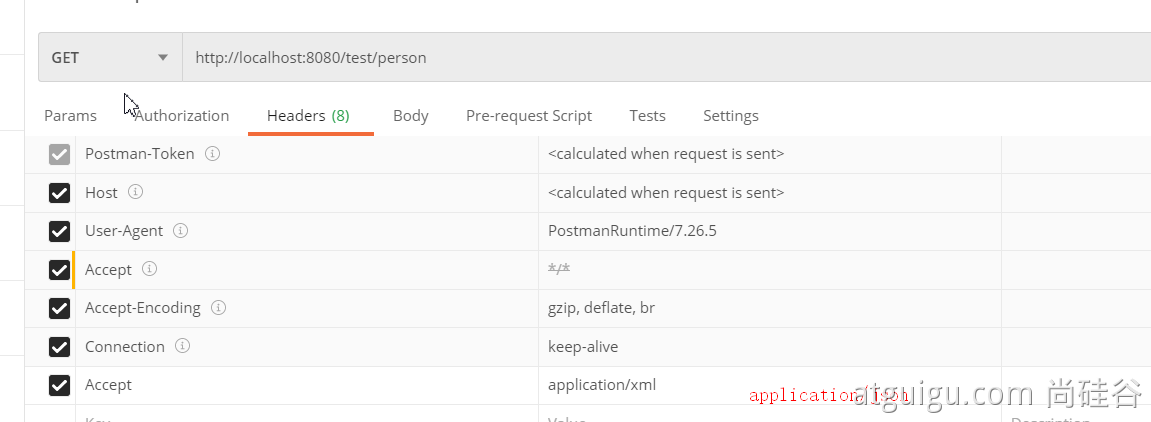
③开启浏览器参数方式内容协商功能
为了方便内容协商,开启基于请求参数的内容协商功能。
spring:
contentnegotiation:
favor-parameter: true #开启请求参数内容协商模式
然后,浏览器地址输入带format参数的URL:
http://localhost:8080/test/person?format=json
或
http://localhost:8080/test/person?format=xml
这样,后端会根据参数format的值,返回对应json或xml格式的数据。

确定客户端接收什么样的内容类型;
1、Parameter策略优先确定是要返回json数据(获取请求头中的format的值)

2、最终进行内容协商返回给客户端json即可。
④内容协商原理
判断当前响应头中是否已经有确定的媒体类型。MediaType
获取客户端(PostMan、浏览器)支持接收的内容类型。(获取客户端Accept请求头字段)【application/xml】
contentNegotiationManager内容协商管理器 默认使用基于请求头的策略
HeaderContentNegotiationStrategy确定客户端可以接收的内容类型
遍历循环所有当前系统的
MessageConverter,看谁支持操作这个对象(Person)找到支持操作
Person的converter,把converter支持的媒体类型统计出来。客户端需要【application/xml】。服务端能力【10种、json、xml】

进行内容协商的最佳匹配媒体类型
用支持将对象转为最佳匹配媒体类型的
converter。调用它进行转化 。
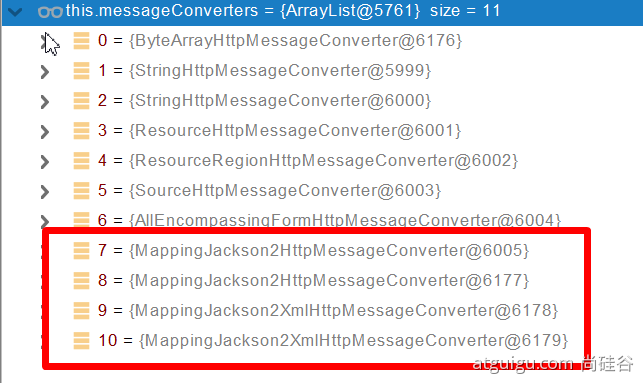
导入了jackson处理xml的包,xml的converter就会自动进来
WebMvcConfigurationSupport
jackson2XmlPresent = ClassUtils.isPresent("com.fasterxml.jackson.dataformat.xml.XmlMapper", classLoader);
if (jackson2XmlPresent) {
Jackson2ObjectMapperBuilder builder = Jackson2ObjectMapperBuilder.xml();
if (this.applicationContext != null) {
builder.applicationContext(this.applicationContext);
}
messageConverters.add(new MappingJackson2XmlHttpMessageConverter(builder.build()));
}
⑤自定义MessageConverter
实现多协议数据兼容。json、xml、x-guigu
@ResponseBody响应数据出去,调用RequestResponseBodyMethodProcessor处理Processor处理方法返回值。通过MessageConverter处理所有
MessageConverter合起来可以支持各种媒体类型数据的操作(读、写)内容协商找到最终的
messageConverter;
想要定制SpringMVC的什么功能。在一个入口给容器中添加一个 WebMvcConfigurer
@Configuration(proxyBeanMethods = false)
public class WebConfig {
@Bean
public WebMvcConfigurer webMvcConfigurer(){
return new WebMvcConfigurer() {
//自定义 MessageConverter
@Override
public void extendMessageConverters(List<HttpMessageConverter<?>> converters) {
converters.add(new GuiguMessageConverter());
}
/**
* 自定义内容协商策略
* @param configurer
*/
@Override
public void configureContentNegotiation(ContentNegotiationConfigurer configurer) {
//Map<String, MediaType> mediaTypes
Map<String, MediaType> mediaTypes = new HashMap<>();
mediaTypes.put("json",MediaType.APPLICATION_JSON);
mediaTypes.put("xml",MediaType.APPLICATION_XML);
mediaTypes.put("gg",MediaType.parseMediaType("application/x-guigu"));
//指定支持解析哪些参数对应的哪些媒体类型
ParameterContentNegotiationStrategy parameterStrategy = new ParameterContentNegotiationStrategy(mediaTypes);
// parameterStrategy.setParameterName("ff");
HeaderContentNegotiationStrategy headeStrategy = new HeaderContentNegotiationStrategy();
configurer.strategies(Arrays.asList(parameterStrategy,headeStrategy));
}
}
}
}
/**
* 自定义的Converter
*/
public class GuiguMessageConverter implements HttpMessageConverter<Person> {
@Override
public boolean canRead(Class<?> clazz, MediaType mediaType) {
return false;
}
@Override
public boolean canWrite(Class<?> clazz, MediaType mediaType) {
return clazz.isAssignableFrom(Person.class);
}
/**
* 服务器要统计所有MessageConverter都能写出哪些内容类型
*
* application/x-guigu
* @return
*/
@Override
public List<MediaType> getSupportedMediaTypes() {
return MediaType.parseMediaTypes("application/x-guigu");
}
@Override
public Person read(Class<? extends Person> clazz, HttpInputMessage inputMessage) throws IOException, HttpMessageNotReadableException {
return null;
}
@Override
public void write(Person person, MediaType contentType, HttpOutputMessage outputMessage) throws IOException, HttpMessageNotWritableException {
//自定义协议数据的写出
String data = person.getUserName()+";"+person.getAge()+";"+person.getBirth();
//写出去
OutputStream body = outputMessage.getBody();
body.write(data.getBytes());
}
}
import java.util.Date;
@Controller
public class ResponseTestController {
/**
* 1、浏览器发请求直接返回 xml [application/xml] jacksonXmlConverter
* 2、如果是ajax请求 返回 json [application/json] jacksonJsonConverter
* 3、如果硅谷app发请求,返回自定义协议数据 [appliaction/x-guigu] xxxxConverter
* 属性值1;属性值2;
*
* 步骤:
* 1、添加自定义的MessageConverter进系统底层
* 2、系统底层就会统计出所有MessageConverter能操作哪些类型
* 3、客户端内容协商 [guigu--->guigu]
*
* 作业:如何以参数的方式进行内容协商
* @return
*/
@ResponseBody //利用返回值处理器里面的消息转换器进行处理
@GetMapping(value = "/test/person")
public Person getPerson(){
Person person = new Person();
person.setAge(28);
person.setBirth(new Date());
person.setUserName("zhangsan");
return person;
}
}
用Postman发送/test/person(请求头Accept:application/x-guigu),将返回自定义协议数据的写出。

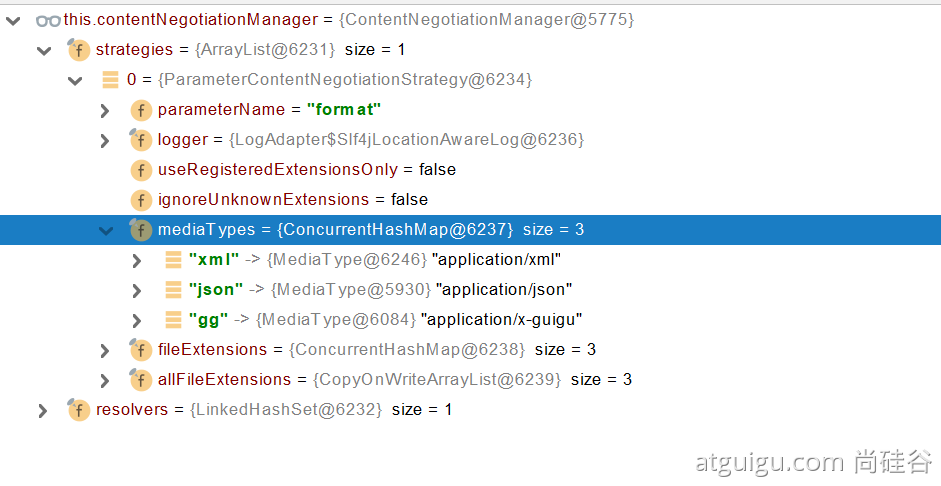
有可能我们添加的自定义的功能会覆盖默认很多功能,导致一些默认的功能失效。
大家考虑,上述功能除了我们完全自定义外?SpringBoot有没有为我们提供基于配置文件的快速修改媒体类型功能?怎么配置呢?【提示:参照SpringBoot官方文档web开发内容协商章节】
5.视图解析与模板引擎
视图解析:SpringBoot默认不支持 JSP,需要引入第三方模板引擎技术实现页面渲染。
5.1 视图解析
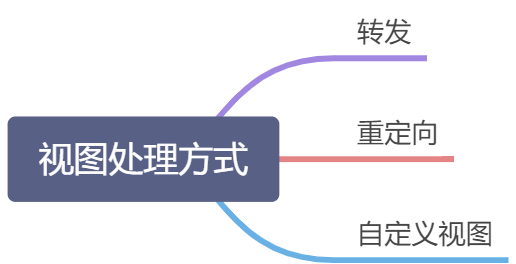
①视图解析原理流程
目标方法处理的过程中,所有数据都会被放在
ModelAndViewContainer里面。包括数据和视图地址方法的参数是一个自定义类型对象(从请求参数中确定的),把他重新放在
ModelAndViewContainer任何目标方法执行完成以后都会返回
ModelAndView(数据和视图地址)。processDispatchResult处理派发结果(页面改如何响应)render(mv, request, response); 进行页面渲染逻辑根据方法的
String返回值得到View对象【定义了页面的渲染逻辑】所有的视图解析器尝试是否能根据当前返回值得到
View对象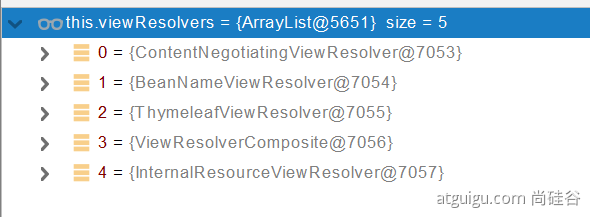
得到了
redirect:/main.html-->Thymeleaf new RedirectView()ContentNegotiationViewResolver里面包含了下面所有的视图解析器,内部还是利用下面所有视图解析器得到视图对象。
view.render(mv.getModelInternal(), request, response); 视图对象调用自定义的render进行页面渲染工作
RedirectView如何渲染【重定向到一个页面】- 获取目标url地址
response.sendRedirect(encodedURL);
视图解析:
返回值以 forward:开始:
new InternalResourceView(forwardUrl); --> 转发request.getRequestDispatcher(path).forward(request, response);返回值以 redirect:开始:
new RedirectView()-->render就是重定向返回值是普通字符串:
new ThymeleafView()--> 自定义视图解析器+自定义视图;
5.2 模板引擎-Thymeleaf
①thymeleaf简介
Thymeleaf is a modern server-side Java template engine for both web and standalone environments, capable of processing HTML, XML, JavaScript, CSS and even plain text.
现代化、服务端Java模板引擎
②基本语法
【1】表达式
| 表达式名字 | 语法 | 用途 |
|---|---|---|
| 变量取值 | ${...} | 获取请求域、session域、对象等值 |
| 选择变量 | *{...} | 获取上下文对象值 |
| 消息 | #{...} | 获取国际化等值 |
| 链接 | @{...} | 生成链接 |
| 片段表达式 | ~{...} | jsp:include 作用,引入公共页面片段 |
【2】字面量
文本值: 'one text' , 'Another one!' ,…
数字: 0 , 34 , 3.0 , 12.3 ,…
布尔值: true , false
空值: null
变量: one,two,.... 变量不能有空格
【3】文本操作
字符串拼接: +
变量替换: |The name is ${name}|
【4】数学运算
运算符: + , - , * , / , %
【5】布尔运算
运算符: and , or
一元运算: ! , not
【6】比较运算
比较: > , < , >= , <= ( gt , lt , ge , le )
等式: == , != ( eq , ne )
【7】条件运算
If-then: (if) ? (then)
If-then-else: (if) ? (then) : (else)
Default: (value) ?: (defaultvalue)
【8】特殊操作
无操作: _
③设置属性值-th:attr
设置单个值
<form action="subscribe.html" th:attr="action=@{/subscribe}">
<fieldset>
<input type="text" name="email" />
<input type="submit" value="Subscribe!" th:attr="value=#{subscribe.submit}"/>
</fieldset>
</form>
设置多个值
<img src="../../https://chunqiurusi-1304032293.cos.ap-chengdu.myqcloud.com/images/Java/gtvglogo.png" th:attr="src=@{/https://chunqiurusi-1304032293.cos.ap-chengdu.myqcloud.com/images/Java/gtvglogo.png},title=#{logo},alt=#{logo}" />
以上两个的代替写法 th:xxxx
<input type="submit" value="Subscribe!" th:value="#{subscribe.submit}"/>
<form action="subscribe.html" th:action="@{/subscribe}">
所有h5兼容的标签写法
https://www.thymeleaf.org/doc/tutorials/3.0/usingthymeleaf.html#setting-value-to-specific-attributes
④迭代
<tr th:each="prod : ${prods}">
<td th:text="${prod.name}">Onions</td>
<td th:text="${prod.price}">2.41</td>
<td th:text="${prod.inStock}? #{true} : #{false}">yes</td>
</tr>
<tr th:each="prod,iterStat : ${prods}" th:class="${iterStat.odd}? 'odd'">
<td th:text="${prod.name}">Onions</td>
<td th:text="${prod.price}">2.41</td>
<td th:text="${prod.inStock}? #{true} : #{false}">yes</td>
</tr>
⑤条件运算
<a href="comments.html"
th:href="@{/product/comments(prodId=${prod.id})}"
th:if="${not #lists.isEmpty(prod.comments)}">view</a>
<div th:switch="${user.role}">
<p th:case="'admin'">User is an administrator</p>
<p th:case="#{roles.manager}">User is a manager</p>
<p th:case="*">User is some other thing</p>
</div>
⑥属性优先级

5.3 thymeleaf使用
①引入Starter
<dependency>
<groupId>org.springframework.boot</groupId>
<artifactId>spring-boot-starter-thymeleaf</artifactId>
</dependency>
②自动配置好了thymeleaf
@Configuration(proxyBeanMethods = false)
@EnableConfigurationProperties(ThymeleafProperties.class)
@ConditionalOnClass({ TemplateMode.class, SpringTemplateEngine.class })
@AutoConfigureAfter({ WebMvcAutoConfiguration.class, WebFluxAutoConfiguration.class })
public class ThymeleafAutoConfiguration { }
自动配好的策略
- 1、所有thymeleaf的配置值都在 ThymeleafProperties
- 2、配置好了 SpringTemplateEngine
- 3、配好了 ThymeleafViewResolver
- 4、我们只需要直接开发页面
public static final String DEFAULT_PREFIX = "classpath:/templates/";
public static final String DEFAULT_SUFFIX = ".html"; //xxx.html
③页面开发
<!DOCTYPE html>
<html lang="en" xmlns:th="http://www.thymeleaf.org">
<head>
<meta charset="UTF-8">
<title>Title</title>
</head>
<body>
<h1 th:text="${msg}">哈哈</h1>
<h2>
<a href="www.atguigu.com" th:href="${link}">去百度</a> <br/>
<a href="www.atguigu.com" th:href="@{link}">去百度2</a>
</h2>
</body>
</html>
server:
servlet:
context-path: /app #设置应用名
这个设置后,URL要插入/app, 如http://localhost:8080/app/hello.html。
5.4 构建后台管理系统
①项目创建
thymeleaf、web-starter、devtools、lombok
②静态资源处理
自动配置好,我们只需要把所有静态资源放到 static 文件夹下
③路径构建
th:action="@{/login}"
④模板抽取
th:insert/replace/include
⑤页面跳转
@PostMapping("/login")
public String main(User user, HttpSession session, Model model){
if(StringUtils.hasLength(user.getUserName()) && "123456".equals(user.getPassword())){
//把登陆成功的用户保存起来
session.setAttribute("loginUser",user);
//登录成功重定向到main.html; 重定向防止表单重复提交
return "redirect:/main.html";
}else {
model.addAttribute("msg","账号密码错误");
//回到登录页面
return "login";
}
}
⑥数据渲染
@GetMapping("/dynamic_table")
public String dynamic_table(Model model){
//表格内容的遍历
List<User> users = Arrays.asList(new User("zhangsan", "123456"),
new User("lisi", "123444"),
new User("haha", "aaaaa"),
new User("hehe ", "aaddd"));
model.addAttribute("users",users);
return "table/dynamic_table";
}
<table class="display table table-bordered" id="hidden-table-info">
<thead>
<tr>
<th>#</th>
<th>用户名</th>
<th>密码</th>
</tr>
</thead>
<tbody>
<tr class="gradeX" th:each="user,stats:${users}">
<td th:text="${stats.count}">Trident</td>
<td th:text="${user.userName}">Internet</td>
<td >[[${user.password}]]</td>
</tr>
</tbody>
</table>
6.拦截器
编写一个拦截器实现
HandlerInterceptor接口拦截器注册到容器中(实现
WebMvcConfigurer的addInterceptors())指定拦截规则(注意,如果是拦截所有,静态资源也会被拦截】
6.1 HandlerInterceptor 接口
/**
* 登录检查
* 1、配置好拦截器要拦截哪些请求
* 2、把这些配置放在容器中
*/
@Slf4j
public class LoginInterceptor implements HandlerInterceptor {
/**
* 目标方法执行之前
* @param request
* @param response
* @param handler
* @return
* @throws Exception
*/
@Override
public boolean preHandle(HttpServletRequest request, HttpServletResponse response, Object handler) throws Exception {
String requestURI = request.getRequestURI();
log.info("preHandle拦截的请求路径是{}",requestURI);
//登录检查逻辑
HttpSession session = request.getSession();
Object loginUser = session.getAttribute("loginUser");
if(loginUser != null){
//放行
return true;
}
//拦截住。未登录。跳转到登录页
request.setAttribute("msg","请先登录");
// re.sendRedirect("/");
request.getRequestDispatcher("/").forward(request,response);
return false;
}
/**
* 目标方法执行完成以后
* @param request
* @param response
* @param handler
* @param modelAndView
* @throws Exception
*/
@Override
public void postHandle(HttpServletRequest request, HttpServletResponse response, Object handler, ModelAndView modelAndView) throws Exception {
log.info("postHandle执行{}",modelAndView);
}
/**
* 页面渲染以后
* @param request
* @param response
* @param handler
* @param ex
* @throws Exception
*/
@Override
public void afterCompletion(HttpServletRequest request, HttpServletResponse response, Object handler, Exception ex) throws Exception {
log.info("afterCompletion执行异常{}",ex);
}
}
6.2 配置拦截器
/**
* 1、编写一个拦截器实现HandlerInterceptor接口
* 2、拦截器注册到容器中(实现WebMvcConfigurer的addInterceptors)
* 3、指定拦截规则【如果是拦截所有,静态资源也会被拦截】
*/
@Configuration
public class AdminWebConfig implements WebMvcConfigurer {
@Override
public void addInterceptors(InterceptorRegistry registry) {
registry.addInterceptor(new LoginInterceptor())
.addPathPatterns("/**") //所有请求都被拦截包括静态资源
.excludePathPatterns("/","/login","/css/**","/fonts/**","/https://chunqiurusi-1304032293.cos.ap-chengdu.myqcloud.com/images/Java/**","/js/**"); //放行的请求
}
}
6.3 拦截器原理
- 根据当前请求,找到
HandlerExecutionChain(可以处理请求的handler以及handler的所有拦截器) - 先来顺序执行所有拦截器的
preHandle()方法。- 如果当前拦截器
preHandle()返回为true。则执行下一个拦截器的preHandle() - 如果当前拦截器返回为
false。直接倒序执行所有已经执行了的拦截器的afterCompletion();。
- 如果当前拦截器
- 如果任何一个拦截器返回
false,直接跳出不执行目标方法。 - 所有拦截器都返回
true,才执行目标方法。 - 倒序执行所有拦截器的
postHandle()方法。 - 前面的步骤有任何异常都会直接倒序触发
afterCompletion()。 - 页面成功渲染完成以后,也会倒序触发
afterCompletion()。

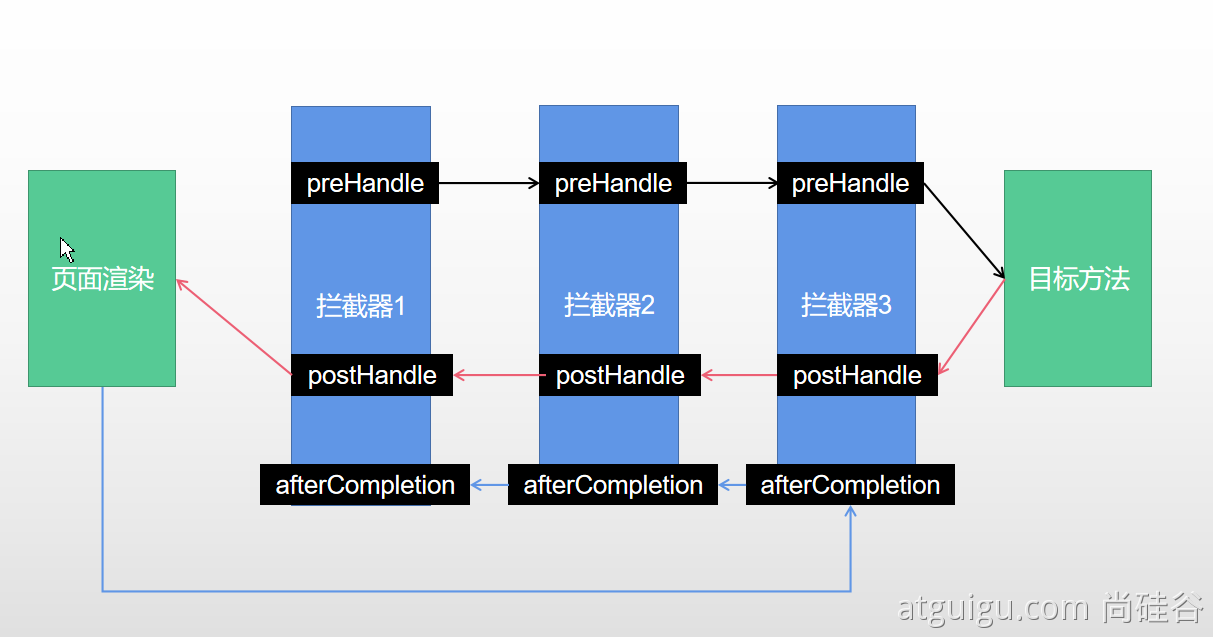
DispatcherServlet中涉及到HandlerInterceptor的地方:
public class DispatcherServlet extends FrameworkServlet {
...
protected void doDispatch(HttpServletRequest request, HttpServletResponse response) throws Exception {
HttpServletRequest processedRequest = request;
HandlerExecutionChain mappedHandler = null;
boolean multipartRequestParsed = false;
WebAsyncManager asyncManager = WebAsyncUtils.getAsyncManager(request);
try {
ModelAndView mv = null;
Exception dispatchException = null;
...
//该方法内调用HandlerInterceptor的preHandle()
if (!mappedHandler.applyPreHandle(processedRequest, response)) {
return;
}
// Actually invoke the handler.
mv = ha.handle(processedRequest, response, mappedHandler.getHandler());
...
//该方法内调用HandlerInterceptor的postHandle()
mappedHandler.applyPostHandle(processedRequest, response, mv);
}
processDispatchResult(processedRequest, response, mappedHandler, mv, dispatchException);
}
catch (Exception ex) {
//该方法内调用HandlerInterceptor接口的afterCompletion方法
triggerAfterCompletion(processedRequest, response, mappedHandler, ex);
}
catch (Throwable err) {
//该方法内调用HandlerInterceptor接口的afterCompletion方法
triggerAfterCompletion(processedRequest, response, mappedHandler,
new NestedServletException("Handler processing failed", err));
}
finally {
...
}
}
private void triggerAfterCompletion(HttpServletRequest request, HttpServletResponse response,
@Nullable HandlerExecutionChain mappedHandler, Exception ex) throws Exception {
if (mappedHandler != null) {
//该方法内调用HandlerInterceptor接口的afterCompletion方法
mappedHandler.triggerAfterCompletion(request, response, ex);
}
throw ex;
}
private void processDispatchResult(HttpServletRequest request, HttpServletResponse response,
@Nullable HandlerExecutionChain mappedHandler, @Nullable ModelAndView mv,
@Nullable Exception exception) throws Exception {
...
if (mappedHandler != null) {
//该方法内调用HandlerInterceptor接口的afterCompletion方法
// Exception (if any) is already handled..
mappedHandler.triggerAfterCompletion(request, response, null);
}
}
}
public class HandlerExecutionChain {
...
boolean applyPreHandle(HttpServletRequest request, HttpServletResponse response) throws Exception {
for (int i = 0; i < this.interceptorList.size(); i++) {
HandlerInterceptor interceptor = this.interceptorList.get(i);
//HandlerInterceptor的preHandle方法
if (!interceptor.preHandle(request, response, this.handler)) {
triggerAfterCompletion(request, response, null);
return false;
}
this.interceptorIndex = i;
}
return true;
}
void applyPostHandle(HttpServletRequest request, HttpServletResponse response, @Nullable ModelAndView mv)
throws Exception {
for (int i = this.interceptorList.size() - 1; i >= 0; i--) {
HandlerInterceptor interceptor = this.interceptorList.get(i);
//HandlerInterceptor接口的postHandle方法
interceptor.postHandle(request, response, this.handler, mv);
}
}
void triggerAfterCompletion(HttpServletRequest request, HttpServletResponse response, @Nullable Exception ex) {
for (int i = this.interceptorIndex; i >= 0; i--) {
HandlerInterceptor interceptor = this.interceptorList.get(i);
try {
//HandlerInterceptor接口的afterCompletion方法
interceptor.afterCompletion(request, response, this.handler, ex);
}
catch (Throwable ex2) {
logger.error("HandlerInterceptor.afterCompletion threw exception", ex2);
}
}
}
}
7.文件上传
7.1 页面表单
页面代码/static/form/form_layouts.html
<form role="form" th:action="@{/upload}" method="post" enctype="multipart/form-data">
<div class="form-group">
<label for="exampleInputEmail1">邮箱</label>
<input type="email" name="email" class="form-control" id="exampleInputEmail1" placeholder="Enter email">
</div>
<div class="form-group">
<label for="exampleInputPassword1">名字</label>
<input type="text" name="username" class="form-control" id="exampleInputPassword1" placeholder="Password">
</div>
<div class="form-group">
<label for="exampleInputFile">头像</label>
<input type="file" name="headerImg" id="exampleInputFile">
</div>
<div class="form-group">
<label for="exampleInputFile">生活照</label>
<input type="file" name="photos" multiple>
</div>
<div class="checkbox">
<label>
<input type="checkbox"> Check me out
</label>
</div>
<button type="submit" class="btn btn-primary">提交</button>
</form>
7.2 文件上传代码
控制层代码:
@Slf4j
@Controller
public class FormTestController {
@GetMapping("/form_layouts")
public String form_layouts(){
return "form/form_layouts";
}
@PostMapping("/upload")
public String upload(@RequestParam("email") String email,
@RequestParam("username") String username,
@RequestPart("headerImg") MultipartFile headerImg,
@RequestPart("photos") MultipartFile[] photos) throws IOException {
log.info("上传的信息:email={},username={},headerImg={},photos={}",
email,username,headerImg.getSize(),photos.length);
if(!headerImg.isEmpty()){
//保存到文件服务器,OSS服务器
String originalFilename = headerImg.getOriginalFilename();
headerImg.transferTo(new File("H:\\cache\\"+originalFilename));
}
if(photos.length > 0){
for (MultipartFile photo : photos) {
if(!photo.isEmpty()){
String originalFilename = photo.getOriginalFilename();
photo.transferTo(new File("H:\\cache\\"+originalFilename));
}
}
}
return "main";
}
}
文件上传相关的配置类:
org.springframework.boot.autoconfigure.web.servlet.MultipartAutoConfigurationorg.springframework.boot.autoconfigure.web.servlet.MultipartProperties
文件大小相关配置项:
spring.servlet.multipart.max-file-size=10MB
spring.servlet.multipart.max-request-size=100MB
7.3 自动配置原理
文件上传自动配置类-MultipartAutoConfiguration-MultipartProperties
- 自动配置好了
StandardServletMultipartResolver【文件上传解析器】 - 原理步骤
- 请求进来使用文件上传解析器判断(
isMultipart)并封装(resolveMultipart,返回MultipartHttpServletRequest)文件上传请求 - 参数解析器来解析请求中的文件内容封装成
MultipartFile - 将
request中文件信息封装为一个Map;MultiValueMap<String, MultipartFile>
- 请求进来使用文件上传解析器判断(
FileCopyUtils。实现文件流的拷贝
@PostMapping("/upload")
public String upload(@RequestParam("email") String email,
@RequestParam("username") String username,
@RequestPart("headerImg") MultipartFile headerImg,
@RequestPart("photos") MultipartFile[] photos)

8.异常处理
Spring Boot官方文档 - Error Handling
8.1 错误处理
①默认规则
默认情况下,Spring Boot提供
/error处理所有错误的映射对于机器客户端,它将生成JSON响应,其中包含错误,HTTP状态和异常消息的详细信息。
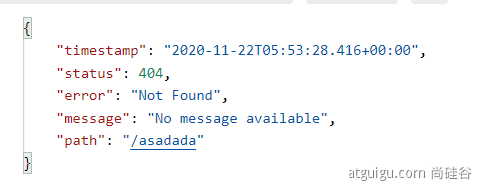
对于浏览器客户端,响应一个“ whitelabel”错误视图,以HTML格式呈现相同的数据

要对其进行自定义,添加
View解析为error要完全替换默认行为,可以实现
ErrorController并注册该类型的Bean定义,或添加ErrorAttributes类型的组件以使用现有机制但替换其内容。/templates/error/下的4xx,5xx页面会被自动解析
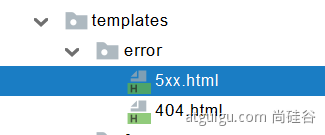
②定制错误处理逻辑
自定义错误页
error/404.htmlerror/5xx.html;有精确的错误状态码页面就匹配精确,没有就找4xx.html;如果都没有就触发白页
@ControllerAdvice+@ExceptionHandler处理全局异常;底层是ExceptionHandlerExceptionResolver支持的
@Slf4j
@ControllerAdvice
public class GlobalExceptionHandler {
@ExceptionHandler({ArithmeticException.class,NullPointerException.class}) //处理异常
public String handleArithException(Exception e){
log.error("异常是:{}",e);
return "login"; //视图地址
}
}
@ResponseStatus+自定义异常 ;底层是ResponseStatusExceptionResolver,把responsestatus注解的信息底层调用response.sendError(statusCode, resolvedReason);tomcat发送的/error
@ResponseStatus(value= HttpStatus.FORBIDDEN,reason = "用户数量太多")
public class UserTooManyException extends RuntimeException {
public UserTooManyException(){
}
public UserTooManyException(String message){
super(message);
}
}
@Controller
public class TableController {
@GetMapping("/dynamic_table")
public String dynamic_table(@RequestParam(value="pn",defaultValue = "1") Integer pn,Model model){
//表格内容的遍历
List<User> users = Arrays.asList(new User("zhangsan", "123456"),
new User("lisi", "123444"),
new User("haha", "aaaaa"),
new User("hehe ", "aaddd"));
model.addAttribute("users",users);
if(users.size()>3){
throw new UserTooManyException();//抛出自定义异常
}
return "table/dynamic_table";
}
}
Spring底层的异常,如参数类型转换异常;
DefaultHandlerExceptionResolver处理框架底层的异常。response.sendError(HttpServletResponse.SC_BAD_REQUEST, ex.getMessage());
自定义实现
HandlerExceptionResolver处理异常;可以作为默认的全局异常处理规则
ErrorViewResolver实现自定义处理异常;response.sendError。error请求就会转给controller- 你的异常没有任何人能处理。tomcat底层
response.sendError。error请求就会转给controller basicErrorController要去的页面地址是ErrorViewResolver;
@Controller
@RequestMapping("${server.error.path:${error.path:/error}}")
public class BasicErrorController extends AbstractErrorController {
...
@RequestMapping(produces = MediaType.TEXT_HTML_VALUE)
public ModelAndView errorHtml(HttpServletRequest request, HttpServletResponse response) {
HttpStatus status = getStatus(request);
Map<String, Object> model = Collections
.unmodifiableMap(getErrorAttributes(request, getErrorAttributeOptions(request, MediaType.TEXT_HTML)));
response.setStatus(status.value());
ModelAndView modelAndView = resolveErrorView(request, response, status, model);
return (modelAndView != null) ? modelAndView : new ModelAndView("error", model);
}
protected ModelAndView resolveErrorView(HttpServletRequest request, HttpServletResponse response, HttpStatus status,
Map<String, Object> model) {
//这里用到ErrorViewResolver接口
for (ErrorViewResolver resolver : this.errorViewResolvers) {
ModelAndView modelAndView = resolver.resolveErrorView(request, status, model);
if (modelAndView != null) {
return modelAndView;
}
}
return null;
}
...
}
@FunctionalInterface
public interface ErrorViewResolver {
ModelAndView resolveErrorView(HttpServletRequest request, HttpStatus status, Map<String, Object> model);
}
③异常处理自动配置原理
ErrorMvcAutoConfiguration自动配置异常处理规则容器中的组件:类型:
DefaultErrorAttributes-> id:errorAttributespublic class DefaultErrorAttributes implements ErrorAttributes, HandlerExceptionResolverDefaultErrorAttributes:定义错误页面中可以包含哪些数据。
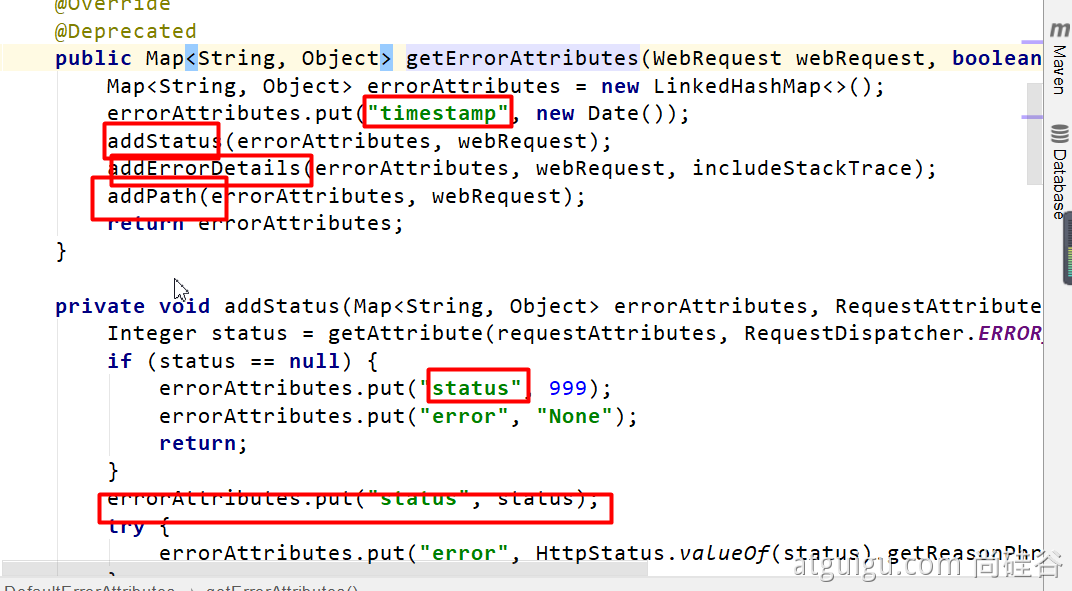
容器中的组件:类型:
BasicErrorController--> id:basicErrorController(json+白页 适配响应)处理默认
/error路径的请求;页面响应new ModelAndView("error", model);容器中有组件
View->id是error;(响应默认错误页)容器中放组件
BeanNameViewResolver(视图解析器);按照返回的视图名作为组件的id去容器中找View对象。
容器中的组件:类型:
DefaultErrorViewResolver-> id:conventionErrorViewResolver- 如果发生错误,会以HTTP的状态码作为视图页地址(viewName),找到真正的页面
- error/404、5xx.html
如果想要返回页面;就会找error视图【StaticView】。(默认是一个白页)
 写出去json
写出去json
 错误页
错误页
④异常处理步骤流程
譬如写一个会抛出异常的控制层:
@Slf4j
@RestController
public class HelloController {
@RequestMapping("/hello")
public String handle01(){
int i = 1 / 0;//将会抛出ArithmeticException
log.info("Hello, Spring Boot 2!");
return "Hello, Spring Boot 2!";
}
}
当浏览器发出/hello请求,DispatcherServlet的doDispatch()的mv = ha.handle(processedRequest, response, mappedHandler.getHandler());将会抛出ArithmeticException。
public class DispatcherServlet extends FrameworkServlet {
...
protected void doDispatch(HttpServletRequest request, HttpServletResponse response) throws Exception {
...
// Actually invoke the handler.
//将会抛出ArithmeticException
mv = ha.handle(processedRequest, response, mappedHandler.getHandler());
applyDefaultViewName(processedRequest, mv);
mappedHandler.applyPostHandle(processedRequest, response, mv);
}
catch (Exception ex) {
//将会捕捉ArithmeticException
dispatchException = ex;
}
catch (Throwable err) {
...
}
//捕捉后,继续运行
processDispatchResult(processedRequest, response, mappedHandler, mv, dispatchException);
}
catch (Exception ex) {
triggerAfterCompletion(processedRequest, response, mappedHandler, ex);
}
catch (Throwable err) {
triggerAfterCompletion(processedRequest, response, mappedHandler,
new NestedServletException("Handler processing failed", err));
}
finally {
...
}
}
private void processDispatchResult(HttpServletRequest request, HttpServletResponse response,
@Nullable HandlerExecutionChain mappedHandler, @Nullable ModelAndView mv,
@Nullable Exception exception) throws Exception {
boolean errorView = false;
if (exception != null) {
if (exception instanceof ModelAndViewDefiningException) {
...
}
else {
Object handler = (mappedHandler != null ? mappedHandler.getHandler() : null);
//ArithmeticException将在这处理
mv = processHandlerException(request, response, handler, exception);
errorView = (mv != null);
}
}
...
}
protected ModelAndView processHandlerException(HttpServletRequest request, HttpServletResponse response,
@Nullable Object handler, Exception ex) throws Exception {
// Success and error responses may use different content types
request.removeAttribute(HandlerMapping.PRODUCIBLE_MEDIA_TYPES_ATTRIBUTE);
// Check registered HandlerExceptionResolvers...
ModelAndView exMv = null;
if (this.handlerExceptionResolvers != null) {
//遍历所有的 handlerExceptionResolvers,看谁能处理当前异常HandlerExceptionResolver处理器异常解析器
for (HandlerExceptionResolver resolver : this.handlerExceptionResolvers) {
exMv = resolver.resolveException(request, response, handler, ex);
if (exMv != null) {
break;
}
}
}
...
//若只有系统的自带的异常解析器(没有自定义的),异常还是会抛出
throw ex;
}
}
系统自带的异常解析器:

DefaultErrorAttributes先来处理异常,它主要功能把异常信息保存到request域,并且返回null。
public class DefaultErrorAttributes implements ErrorAttributes, HandlerExceptionResolver, Ordered {
...
public ModelAndView resolveException(HttpServletRequest request, HttpServletResponse response, Object handler, Exception ex) {
this.storeErrorAttributes(request, ex);
return null;
}
private void storeErrorAttributes(HttpServletRequest request, Exception ex) {
request.setAttribute(ERROR_ATTRIBUTE, ex);//把异常信息保存到request域
}
...
}
默认没有任何解析器(上图的
HandlerExceptionResolverComposite)能处理异常,所以最后异常会被抛出。最终底层就会转发
/error请求。会被底层的BasicErrorController处理。
@Controller
@RequestMapping("${server.error.path:${error.path:/error}}")
public class BasicErrorController extends AbstractErrorController {
@RequestMapping(produces = MediaType.TEXT_HTML_VALUE)
public ModelAndView errorHtml(HttpServletRequest request, HttpServletResponse response) {
HttpStatus status = getStatus(request);
Map<String, Object> model = Collections
.unmodifiableMap(getErrorAttributes(request, getErrorAttributeOptions(request, MediaType.TEXT_HTML)));
response.setStatus(status.value());
ModelAndView modelAndView = resolveErrorView(request, response, status, model);
//如果/template/error内没有4**.html或5**.html,
//modelAndView为空,最终还是返回viewName为error的modelAndView
return (modelAndView != null) ? modelAndView : new ModelAndView("error", model);
}
...
}
protected void doDispatch(HttpServletRequest request, HttpServletResponse response) throws Exception {
...
protected void doDispatch(HttpServletRequest request, HttpServletResponse response) throws Exception {
...
// Actually invoke the handler.
mv = ha.handle(processedRequest, response, mappedHandler.getHandler());
...
//渲染页面
processDispatchResult(processedRequest, response, mappedHandler, mv, dispatchException);
...
}
private void processDispatchResult(HttpServletRequest request, HttpServletResponse response,
@Nullable HandlerExecutionChain mappedHandler, @Nullable ModelAndView mv,
@Nullable Exception exception) throws Exception {
boolean errorView = false;
...
// Did the handler return a view to render?
if (mv != null && !mv.wasCleared()) {
render(mv, request, response);
if (errorView) {
WebUtils.clearErrorRequestAttributes(request);
}
}
...
}
protected void render(ModelAndView mv, HttpServletRequest request, HttpServletResponse response) throws Exception {
...
View view;
String viewName = mv.getViewName();
if (viewName != null) {
// We need to resolve the view name.
//找出合适error的View,如果/template/error内没有4**.html或5**.html,
//将会返回默认异常页面ErrorMvcAutoConfiguration.StaticView
//这里按需深究代码吧!
view = resolveViewName(viewName, mv.getModelInternal(), locale, request);
...
}
...
try {
if (mv.getStatus() != null) {
response.setStatus(mv.getStatus().value());
}
//看下面代码块的StaticView的render块
view.render(mv.getModelInternal(), request, response);
}
catch (Exception ex) {
...
}
}
}
@Configuration(proxyBeanMethods = false)
@ConditionalOnWebApplication(type = Type.SERVLET)
@ConditionalOnClass({ Servlet.class, DispatcherServlet.class })
// Load before the main WebMvcAutoConfiguration so that the error View is available
@AutoConfigureBefore(WebMvcAutoConfiguration.class)
@EnableConfigurationProperties({ ServerProperties.class, ResourceProperties.class, WebMvcProperties.class })
public class ErrorMvcAutoConfiguration {
...
@Configuration(proxyBeanMethods = false)
@ConditionalOnProperty(prefix = "server.error.whitelabel", name = "enabled", matchIfMissing = true)
@Conditional(ErrorTemplateMissingCondition.class)
protected static class WhitelabelErrorViewConfiguration {
//将创建一个名为error的系统默认异常页面View的Bean
private final StaticView defaultErrorView = new StaticView();
@Bean(name = "error")
@ConditionalOnMissingBean(name = "error")
public View defaultErrorView() {
return this.defaultErrorView;
}
// If the user adds @EnableWebMvc then the bean name view resolver from
// WebMvcAutoConfiguration disappears, so add it back in to avoid disappointment.
@Bean
@ConditionalOnMissingBean
public BeanNameViewResolver beanNameViewResolver() {
BeanNameViewResolver resolver = new BeanNameViewResolver();
resolver.setOrder(Ordered.LOWEST_PRECEDENCE - 10);
return resolver;
}
}
private static class StaticView implements View {
private static final MediaType TEXT_HTML_UTF8 = new MediaType("text", "html", StandardCharsets.UTF_8);
private static final Log logger = LogFactory.getLog(StaticView.class);
@Override
public void render(Map<String, ?> model, HttpServletRequest request, HttpServletResponse response)
throws Exception {
if (response.isCommitted()) {
String message = getMessage(model);
logger.error(message);
return;
}
response.setContentType(TEXT_HTML_UTF8.toString());
StringBuilder builder = new StringBuilder();
Object timestamp = model.get("timestamp");
Object message = model.get("message");
Object trace = model.get("trace");
if (response.getContentType() == null) {
response.setContentType(getContentType());
}
//系统默认异常页面html代码
builder.append("<html><body><h1>Whitelabel Error Page</h1>").append(
"<p>This application has no explicit mapping for /error, so you are seeing this as a fallback.</p>")
.append("<div id='created'>").append(timestamp).append("</div>")
.append("<div>There was an unexpected error (type=").append(htmlEscape(model.get("error")))
.append(", status=").append(htmlEscape(model.get("status"))).append(").</div>");
if (message != null) {
builder.append("<div>").append(htmlEscape(message)).append("</div>");
}
if (trace != null) {
builder.append("<div style='white-space:pre-wrap;'>").append(htmlEscape(trace)).append("</div>");
}
builder.append("</body></html>");
response.getWriter().append(builder.toString());
}
private String htmlEscape(Object input) {
return (input != null) ? HtmlUtils.htmlEscape(input.toString()) : null;
}
private String getMessage(Map<String, ?> model) {
Object path = model.get("path");
String message = "Cannot render error page for request [" + path + "]";
if (model.get("message") != null) {
message += " and exception [" + model.get("message") + "]";
}
message += " as the response has already been committed.";
message += " As a result, the response may have the wrong status code.";
return message;
}
@Override
public String getContentType() {
return "text/html";
}
}
}
总结:
执行目标方法,目标方法运行期间有任何异常都会被catch、而且标志当前请求结束;并且用
dispatchException进入视图解析流程(页面渲染?)
processDispatchResult(processedRequest, response, mappedHandler, mv, dispatchException);mv = processHandlerException;处理handler发生的异常,处理完成返回ModelAndView;遍历所有的
handlerExceptionResolvers,看谁能处理当前异常【HandlerExceptionResolver处理器异常解析器**】**
系统默认的异常解析器;

DefaultErrorAttributes先来处理异常。把异常信息保存到request域,并且返回null;默认没有任何人能处理异常,所以异常会被抛出
如果没有任何人能处理最终底层就会发送
/error请求。会被底层的BasicErrorController处理解析错误视图;遍历所有的
ErrorViewResolver看谁能解析。
默认的
DefaultErrorViewResolver,作用是把响应状态码作为错误页的地址,error/500.html模板引擎最终响应这个页面
error/500.html
9.Web原生组件注入(Servlet、Filter、Listener)
官方文档 - Servlets, Filters, and listeners
9.1 使用Servlet原生API
@ServletComponentScan(basePackages = "com.atguigu.admin"):指定原生Servlet组件都放在那里@WebServlet(urlPatterns = "/my"):效果:直接响应,没有经过Spring的拦截器?@WebFilter(urlPatterns={"/css/*","/images/*"})@WebListener
推荐可以这种方式;
@WebServlet(urlPatterns = "/my")
public class MyServlet extends HttpServlet {
@Override
protected void doGet(HttpServletRequest req, HttpServletResponse resp) throws ServletException, IOException {
resp.getWriter().write("66666");
}
}
@Slf4j
@WebFilter(urlPatterns={"/css/*","/images/*"}) //my
public class MyFilter implements Filter {
@Override
public void init(FilterConfig filterConfig) throws ServletException {
log.info("MyFilter初始化完成");
}
@Override
public void doFilter(ServletRequest request, ServletResponse response, FilterChain chain) throws IOException, ServletException {
log.info("MyFilter工作");
chain.doFilter(request,response);
}
@Override
public void destroy() {
log.info("MyFilter销毁");
}
}
@Slf4j
@WebListener
public class MyServletContextListener implements ServletContextListener {
@Override
public void contextInitialized(ServletContextEvent sce) {
log.info("MySwervletContextListener监听到项目初始化完成");
}
@Override
public void contextDestroyed(ServletContextEvent sce) {
log.info("MySwervletContextListener监听到项目销毁");
}
}
最后还要在主启动类添加注解@ServletComponentScan
@ServletComponentScan(basePackages = "com.atguigu.admin")
@SpringBootApplication(exclude = RedisAutoConfiguration.class)
public class Boot05WebAdminApplication {
public static void main(String[] args) {
SpringApplication.run(Boot05WebAdminApplication.class, args);
}
}
扩展:DispatchServlet 如何注册进来
- 容器中自动配置了
DispatcherServlet属性绑定到WebMvcProperties;对应的配置文件配置项是spring.mvc。 - 通过
ServletRegistrationBean<DispatcherServlet>把DispatcherServlet配置进来。 - 默认映射的是 / 路径。
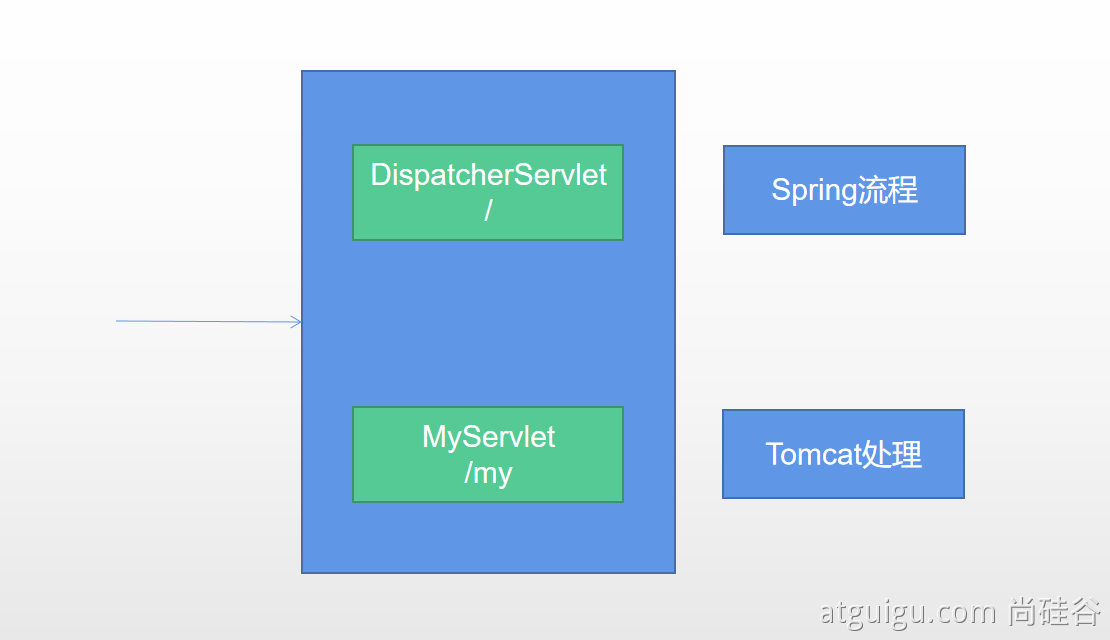
Tomcat-Servlet;
多个Servlet都能处理到同一层路径,精确优选原则
A: /my/
B: /my/1
9.2 使用spring方式注入
通过 RegistrationBean 实现注入
ServletRegistrationBeanFilterRegistrationBeanServletListenerRegistrationBean
@Configuration
public class MyRegistConfig {
@Bean
public ServletRegistrationBean myServlet(){
MyServlet myServlet = new MyServlet();
return new ServletRegistrationBean(myServlet,"/my","/my02");
}
@Bean
public FilterRegistrationBean myFilter(){
MyFilter myFilter = new MyFilter();
// return new FilterRegistrationBean(myFilter,myServlet());
FilterRegistrationBean filterRegistrationBean = new FilterRegistrationBean(myFilter);
filterRegistrationBean.setUrlPatterns(Arrays.asList("/my","/css/*"));
return filterRegistrationBean;
}
@Bean
public ServletListenerRegistrationBean myListener(){
MySwervletContextListener mySwervletContextListener = new MySwervletContextListener();
return new ServletListenerRegistrationBean(mySwervletContextListener);
}
}
10.嵌入式Servlet容器
10.1 切换嵌入式Servlet容器
默认支持的webServer
Tomcat,Jetty, orUndertowServletWebServerApplicationContext容器启动寻找ServletWebServerFactory并引导创建服务器
切换服务器

<dependency>
<groupId>org.springframework.boot</groupId>
<artifactId>spring-boot-starter-web</artifactId>
<exclusions>
<exclusion>
<groupId>org.springframework.boot</groupId>
<artifactId>spring-boot-starter-tomcat</artifactId>
</exclusion>
</exclusions>
</dependency>
- 原理
- SpringBoot应用启动发现当前是Web应用,web场景包-导入tomcat。
- web应用会创建一个web版的IOC容器
ServletWebServerApplicationContext。 ServletWebServerApplicationContext启动的时候寻找ServletWebServerFactory(Servlet 的web服务器工厂——>Servlet 的web服务器)。- SpringBoot底层默认有很多的WebServer工厂(
ServletWebServerFactoryConfiguration内创建Bean),如:TomcatServletWebServerFactoryJettyServletWebServerFactoryUndertowServletWebServerFactory
- 底层直接会有一个自动配置类
ServletWebServerFactoryAutoConfiguration。 ServletWebServerFactoryAutoConfiguration导入了ServletWebServerFactoryConfiguration(配置类)。ServletWebServerFactoryConfiguration根据动态判断系统中到底导入了哪个Web服务器的包。(默认是web-starter导入tomcat包),容器中就有TomcatServletWebServerFactoryTomcatServletWebServerFactory创建出Tomcat服务器并启动;TomcatWebServer的构造器拥有初始化方法initialize——this.tomcat.start();- 内嵌服务器,与以前手动把启动服务器相比,改成现在使用代码启动(tomcat核心jar包存在)
Spring Boot默认使用Tomcat服务器,若需更改其他服务器,则修改工程pom.xml:
<dependency>
<groupId>org.springframework.boot</groupId>
<artifactId>spring-boot-starter-web</artifactId>
<exclusions>
<exclusion>
<groupId>org.springframework.boot</groupId>
<artifactId>spring-boot-starter-tomcat</artifactId>
</exclusion>
</exclusions>
</dependency>
<dependency>
<groupId>org.springframework.boot</groupId>
<artifactId>spring-boot-starter-jetty</artifactId>
</dependency>
10.2 定制Servlet容器
实现
WebServerFactoryCustomizer<ConfigurableServletWebServerFactory>- 把配置文件的值和
ServletWebServerFactory进行绑定
- 把配置文件的值和
修改配置文件
server.xxx直接自定义
ConfigurableServletWebServerFactory
xxxxxCustomizer:定制化器,可以改变xxxx的默认规则
import org.springframework.boot.web.server.WebServerFactoryCustomizer;
import org.springframework.boot.web.servlet.server.ConfigurableServletWebServerFactory;
import org.springframework.stereotype.Component;
@Component
public class CustomizationBean implements WebServerFactoryCustomizer<ConfigurableServletWebServerFactory> {
@Override
public void customize(ConfigurableServletWebServerFactory server) {
server.setPort(9000);
}
}
11.定制化原理
11.1 定制化的常见方式
修改配置文件
xxxxxCustomizer编写自定义的配置类
xxxConfiguration+@Bean替换、增加容器中默认组件,视图解析器Web应用 编写一个配置类实现
WebMvcConfigurer即可定制化web功能 +@Bean给容器中再扩展一些组件
@Configuration
public class AdminWebConfig implements WebMvcConfigurer{
}
@EnableWebMvc+WebMvcConfigurer—@Bean可以全面接管SpringMVC,所有规则全部自己重新配置; 实现定制和扩展功能(高级功能,初学者退避三舍)。- 原理:
WebMvcAutoConfiguration默认的SpringMVC的自动配置功能类,如静态资源、欢迎页等。- 一旦使用
@EnableWebMvc,会@Import(DelegatingWebMvcConfiguration.class)。 DelegatingWebMvcConfiguration的作用,只保证SpringMVC最基本的使用- 把所有系统中的
WebMvcConfigurer拿过来,所有功能的定制都是这些WebMvcConfigurer合起来一起生效。 - 自动配置了一些非常底层的组件,如
RequestMappingHandlerMapping,这些组件依赖的组件都是从容器中获取如。 public class DelegatingWebMvcConfiguration extends WebMvcConfigurationSupport。
- 把所有系统中的
WebMvcAutoConfiguration里面的配置要能生效必须@ConditionalOnMissingBean(WebMvcConfigurationSupport.class)。@EnableWebMvc导致了WebMvcAutoConfiguration失效。
- 原理:
11.2 原理分析套路
场景starter - xxxxAutoConfiguration - 导入xxx组件 - 绑定xxxProperties -- 绑定配置文件项

